There are lots of SEO keyword tracking tools. And picking the best one for you can be challenging.
This list of keyword rank tracking tools runs through 11 platforms, including pricing, who I recommend them for, and notable tool features.
11 Best Keyword Tracking Tools
I tracked 30 keywords for each tool (except for Google Search Console) to see which features I liked best and how each tool compares.
Here’s what I found:
1. Semrush
- Best for: Marketers, SEOs, and agency professionals who want accurate, in-depth data that’s easy to understand and personalized to their sites
- Free basic version available: Yes
- Pricing: Pro ($139.95/month), Guru ($249.95/month), and Business ($499.95/month)
- Free trial period: Seven days
Semrush’s Position Tracking tool lets you monitor daily search engine ranking changes across a set of custom keywords for specific devices and locations (down to the ZIP code). And it integrates with Google’s Looker Studio for those who want to build custom reports.
Besides displaying standard ranking changes, Position Tracking:
- Shows you how your competitors are performing
- Highlights keyword cannibalization issues (when multiple pages rank for the same keyword and have the potential to harm your rankings)
- Shows which SERP features (e.g., featured snippets, local packs, AI Overviews, etc.) appear for a keyword and which ones you rank for
- Gives you metrics like share of voice and visibility to help you understand your overall organic performance
- Lets you tag keywords to organize and keep track of large datasets
And you can set custom email alerts that ping you when certain rankings change.
Get started with Position Tracking by following our configuration steps.
Once the tool is ready, visit the “Landscape” report for a summary of your progress.
You’ll see your top keywords. And which keywords had a positive and negative impact (the keywords that saw the biggest increases or drops in rankings during a given period).
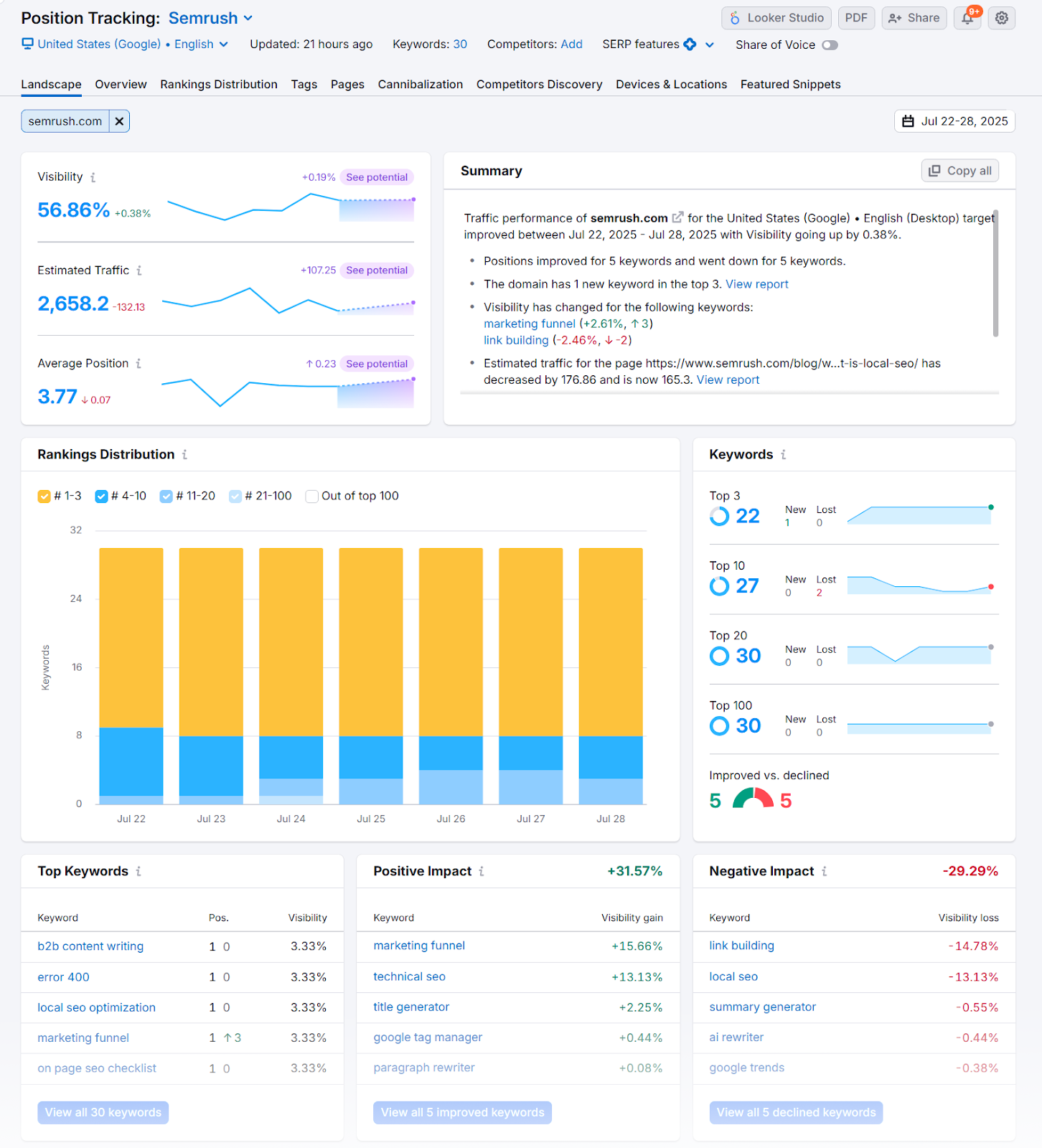
What I Like
Semrush’s Potential Growth is an AI traffic prediction metric that grades keywords based on their potential to bring you traffic.
Sorting keywords by “Your Pot. Growth” helps you spot keywords to prioritize based on how much your traffic could increase by optimizing for each keyword.
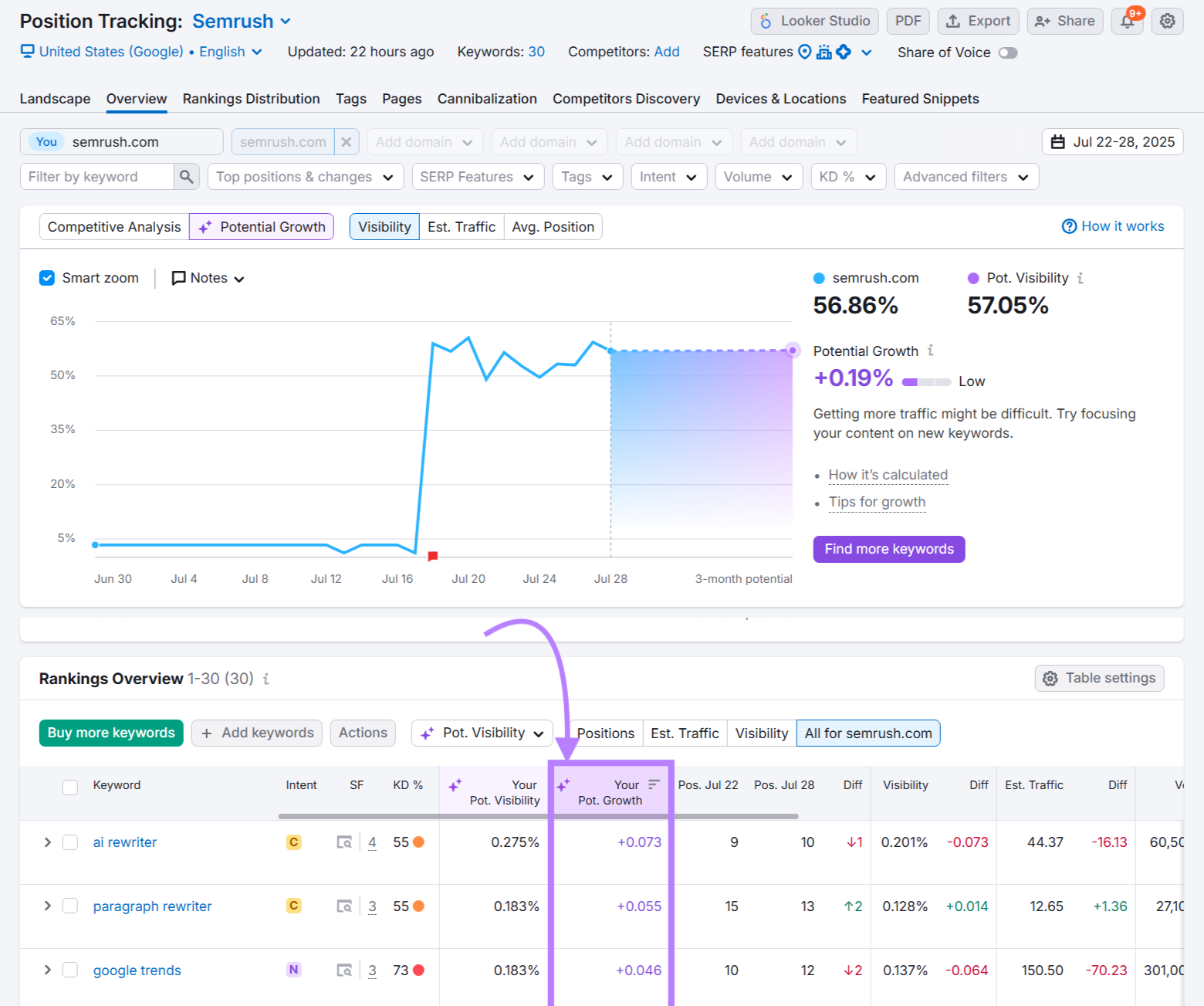
And the “SERP Features” chart (under the “Landscape” tab) gives you a quick assessment of your SERP feature performance.

Simply click on a SERP feature bar to view all of its keywords—both the ones you rank for and the ones you don’t.
2. Ahrefs
- Best for: SEOs who want rich keyword data
- Free basic version available: No
- Pricing: Lite ($129/month), Standard ($249/month), Advanced ($449/month), and Enterprise ($1,499/month)
- Free trial period: No
Ahrefs’ Rank Tracker is a keyword tracking tool that gives you weekly updates for each keyword—along with an overall summary—including metrics like share of voice, average position, estimated traffic, and SERP features.
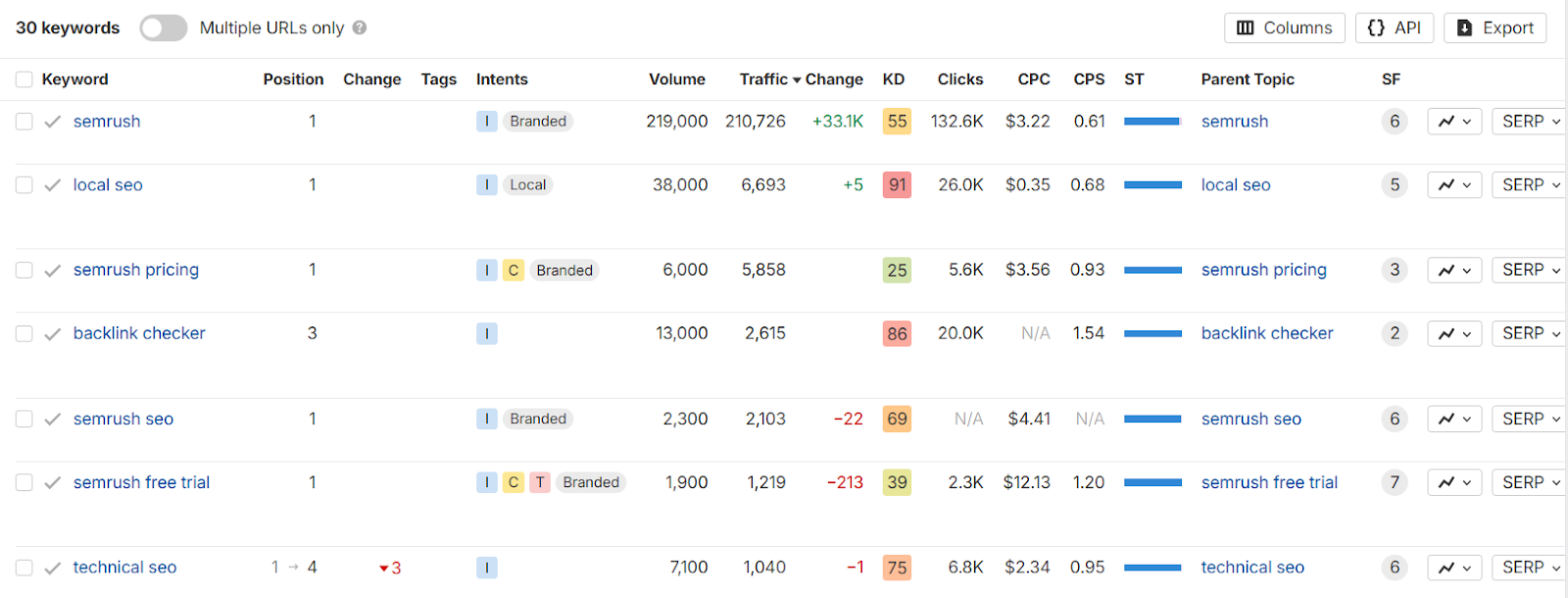
You can track local keywords down to the ZIP code level. And you can compare yourself against competitors to potentially spot opportunities where you can outrank your rivals.
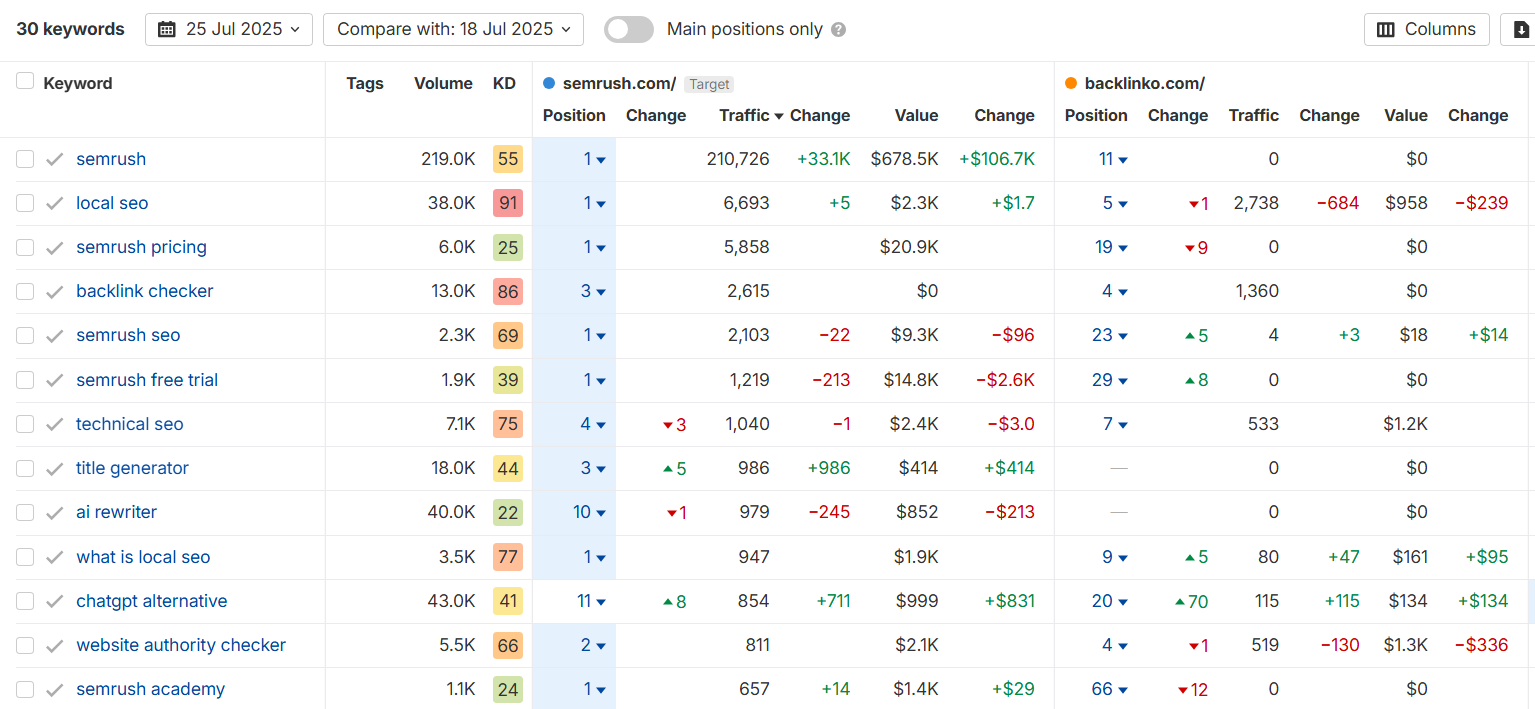
Ahrefs’ Rank Tracker includes information on SERP features like featured snippets, local packs, and knowledge panels.
You can also group and review keywords with custom tags. And toggling on “Multiple URLs” shows potential keyword cannibalization issues.

What I Like
I like how Ahrefs’ keyword tracking tool includes a “Parent Topic” column, which helps users consider whether they can optimize a page for a broader keyword to capture more traffic.
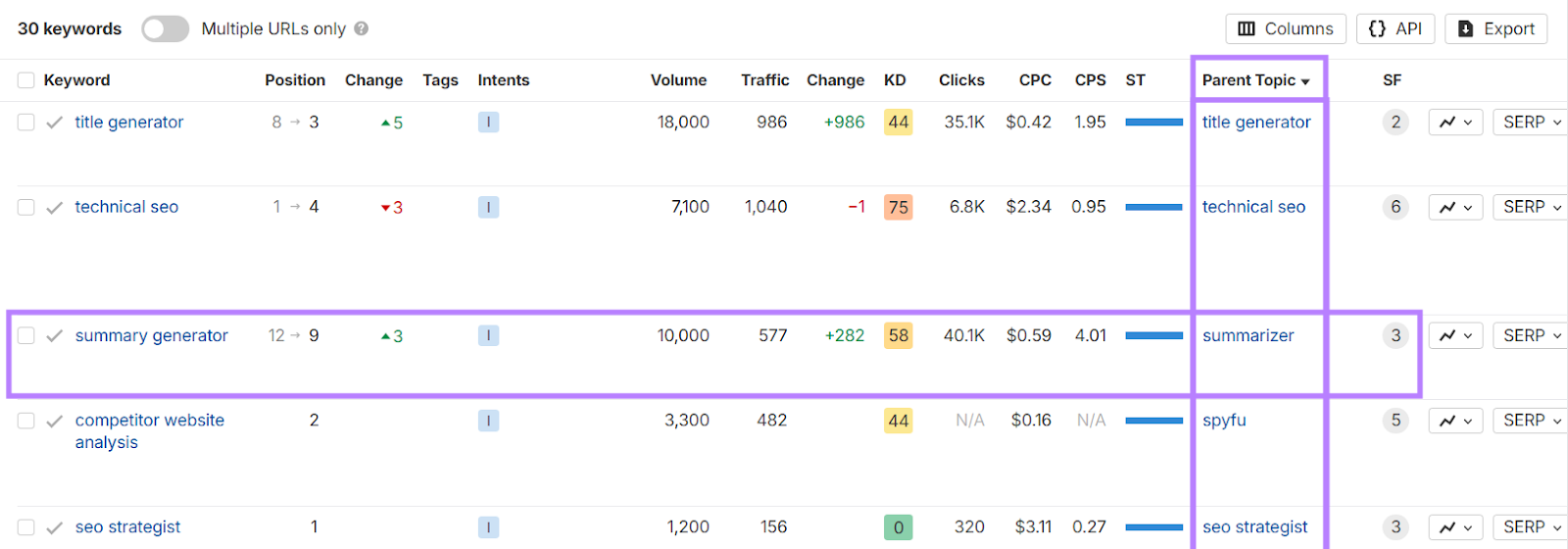
You can use this information to determine whether you should consolidate multiple pages together that fall under the same parent topic.
I also like that Ahrefs has a visual SERP overview where users can compare two days. Which might give you insight during algorithm updates. As you can see which sites are moving up and down.
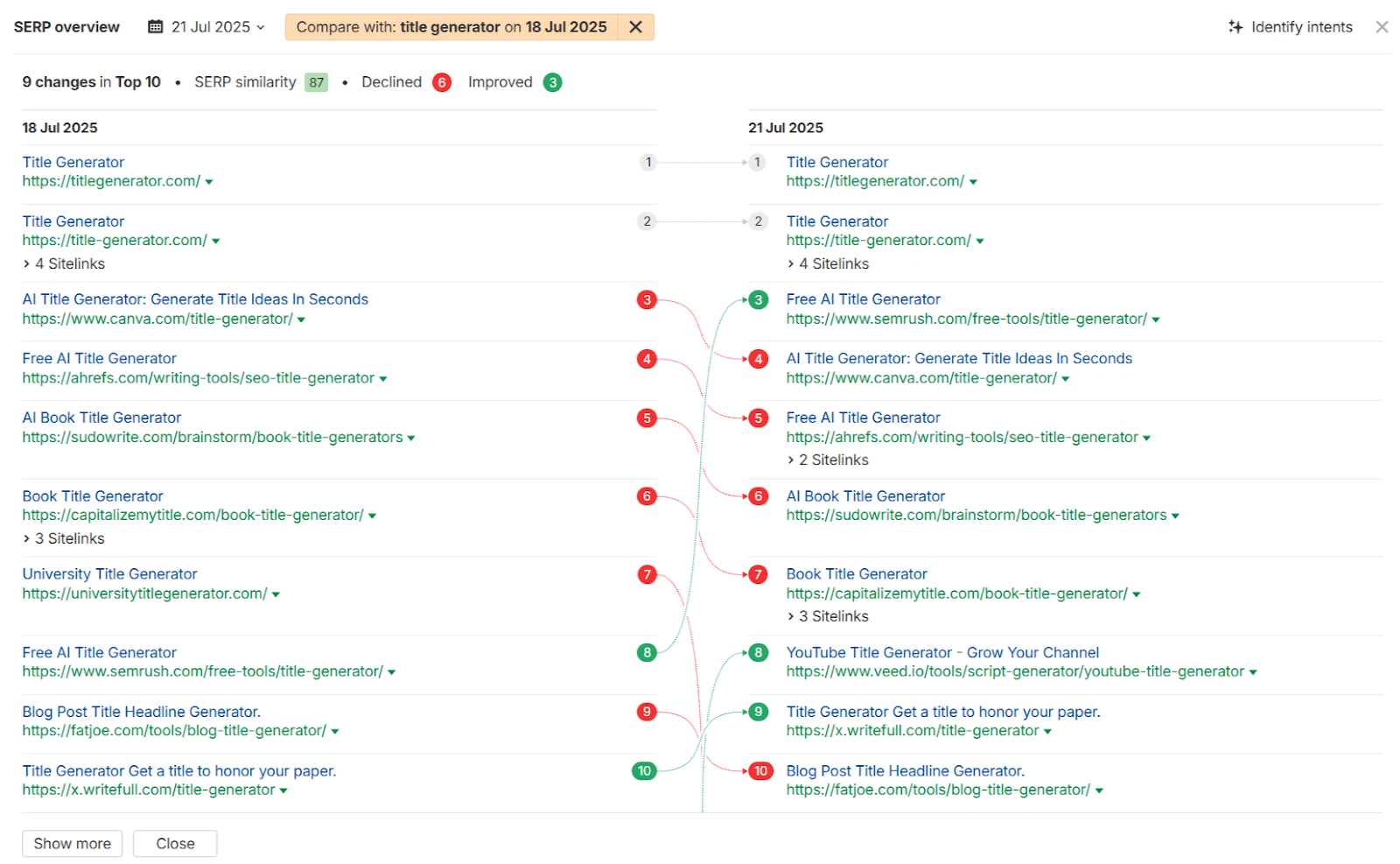
3. SE Ranking
- Best for: SEOs who need hyper-frequent rank data (e.g., ecommerce, news, or teams running time-sensitive SEO campaigns)
- Free basic version available: No
- Pricing: Essential ($65/month), Pro ($119/month), and Business ($259/month)
- Free trial period: 14 days
SE Ranking’s Rank Tracker helps you monitor your rankings across Google, Bing, Yahoo, and YouTube.
You can see which keywords you’re tracking, how their positions change over time, and whether your pages appear in SERP features.
You’re able to track keywords using countries, regions, or ZIP codes.
And a drop-down next to each keyword reveals its ranking history. So you can evaluate performance at a glance.

And the insights widget highlights areas you might want to focus on to improve your rankings.

What I Like
SE Ranking’s keyword tracking tool has a Content Score that compares your page to top-ranking competitors so you can identify and prioritize which pages to optimize.
You can also manually recheck keyword data outside of scheduled updates. So you can get updated data when you need it.
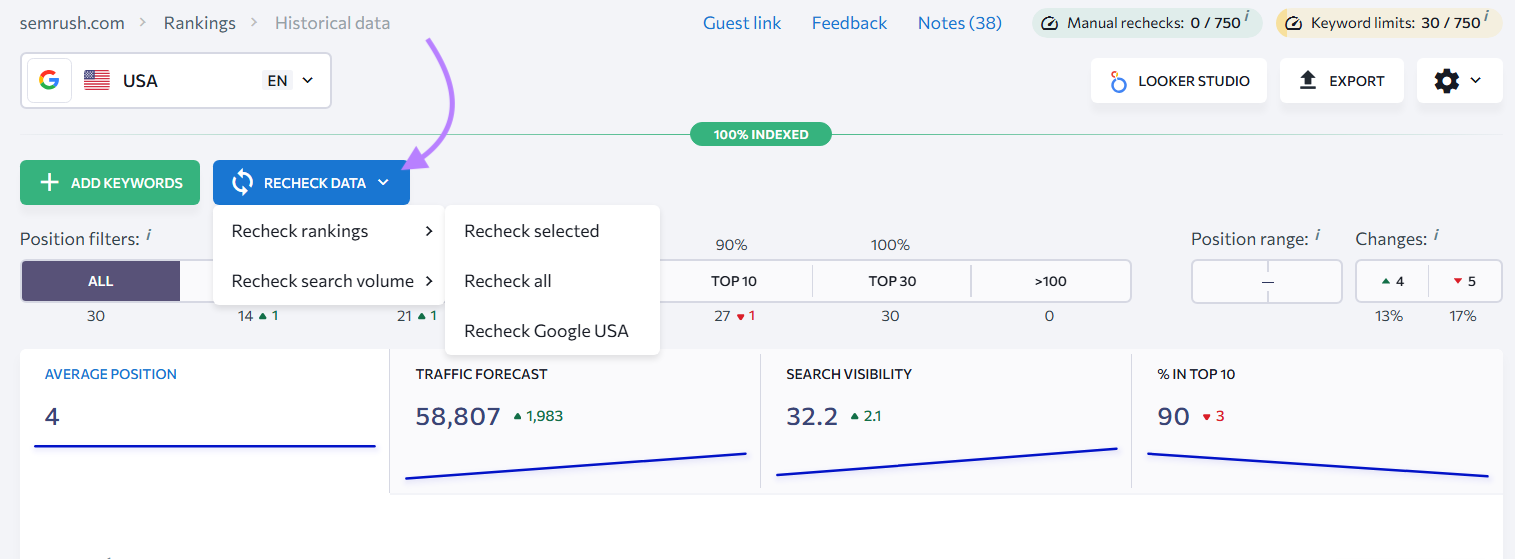
For example, you might want to keep a close eye on your rankings if you recently migrated your site.
4. AccuRanker
- Best for: SEOs with large keyword datasets
- Free basic version available: No
- Pricing: Starts at $129 for 1,000 keywords
- Free trial period: 14 days
AccuRanker is a keyword tracking tool that offers keyword position monitoring for your site and competing sites with daily updates.
Like other keyword tracking tools, you get metrics for each keyword like average position, SERP features, and share of voice. AccuRanker also has reports for tracking your keywords within AI Overviews.
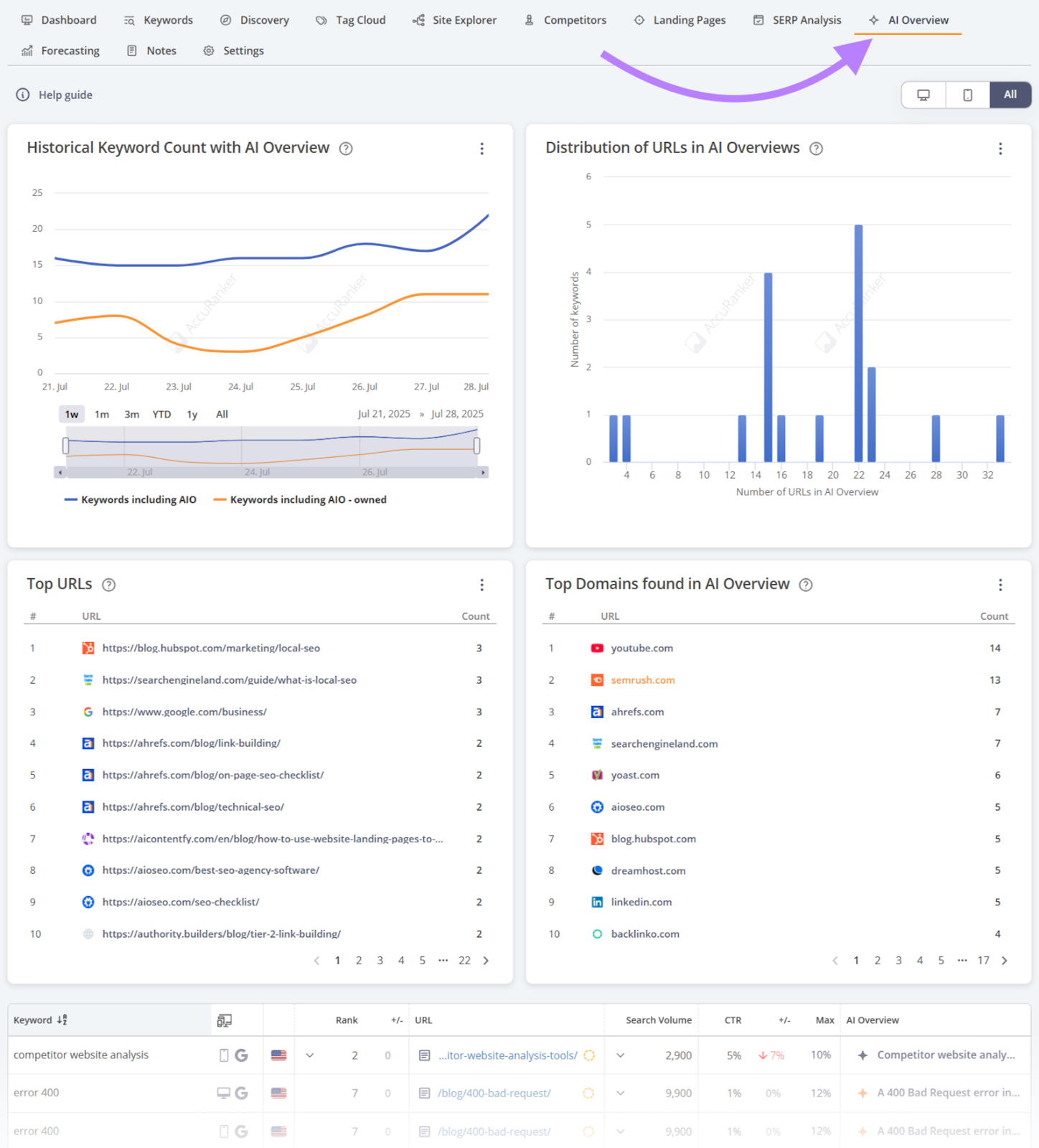
You can also see how many pixels your site appears from the top of the SERP. Giving you a clearer picture of how visible your listing really is.

This adds important context to your rankings. Because even if you’re in position two, you might still be buried below ads or other SERP features.
What I Like
I like AccuRanker’s autocorrect feature, which is useful for times when you need to track a keyword that people often misspell—like your brand name.
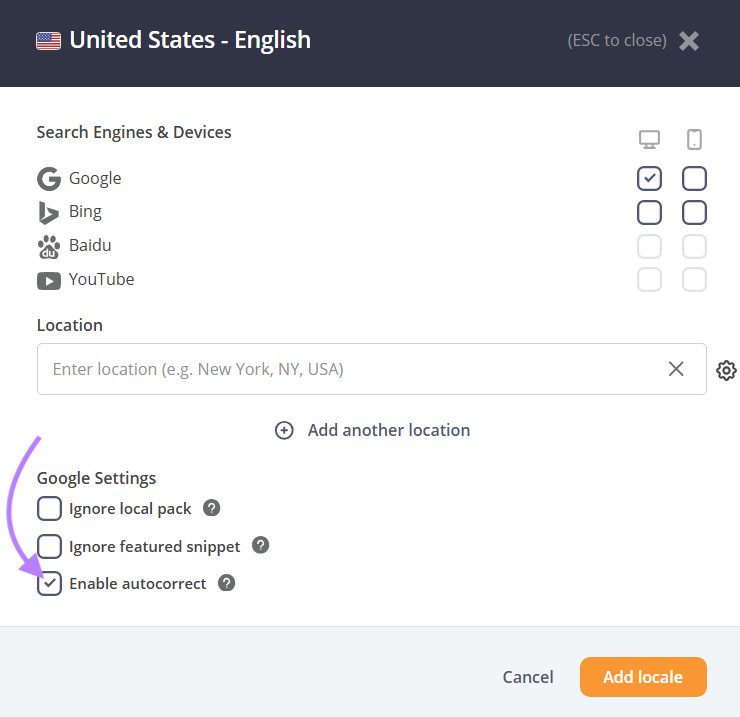
Google automatically autocorrects certain terms. For example, Google automatically corrects a search for “sem rush” to “semrush.”
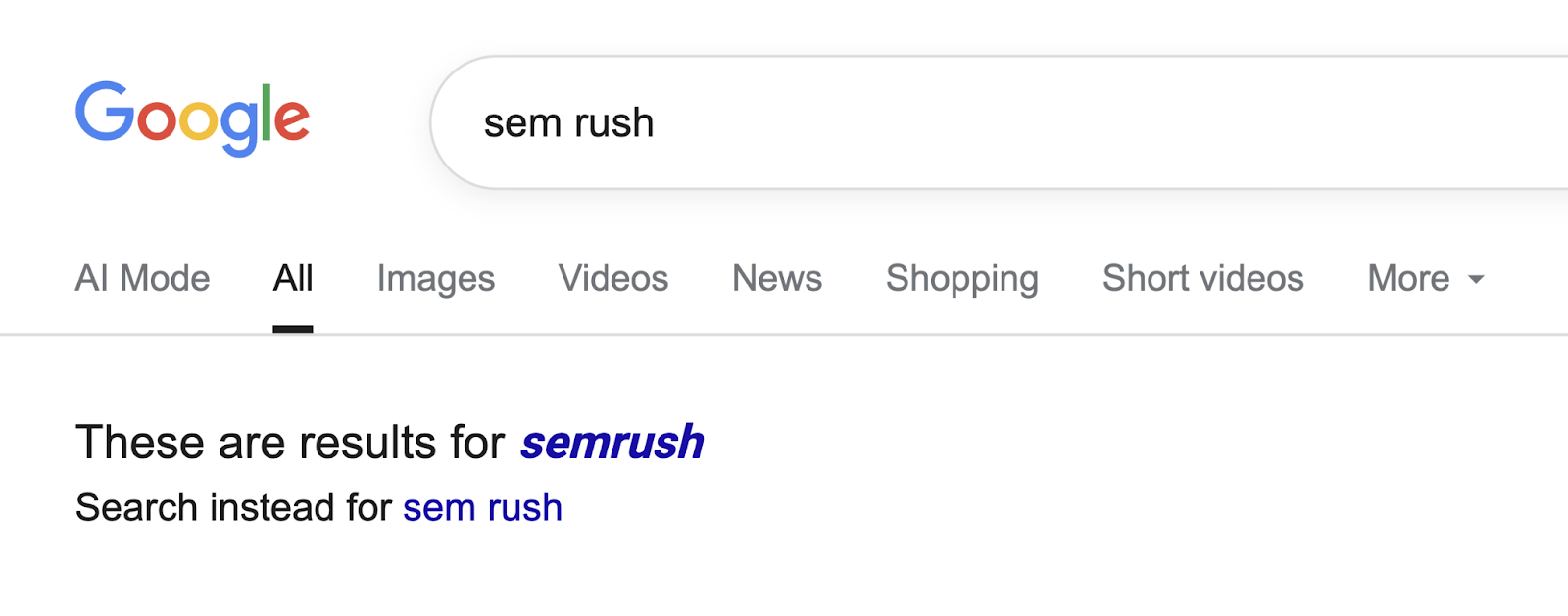
With autocorrect enabled in AccuRanker, you can see rankings that reflect how Google actually treats the query. Giving you more accurate data when users spell things wrong but still land on your site.
And autotagging is useful for those who need to organize a large dataset. You can set up rules to manage this.
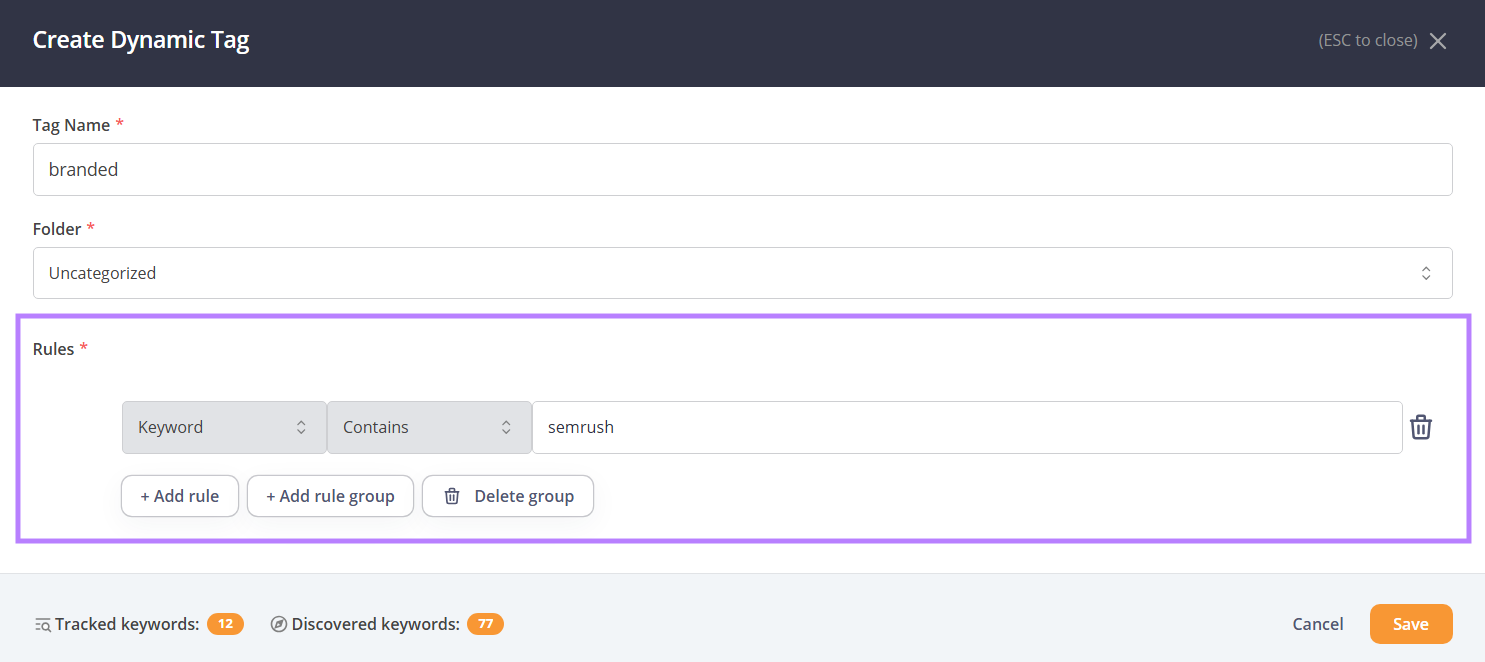
5. Serpstat
- Best for: Teams managing large websites with extensive content silos
- Free basic version available: No
- Pricing: Individual ($69/month), Team ($129/month), and Agency ($499/month)
- Free trial period: Seven days
Serpstat’s Keyword Rank Tracker tracks keywords across devices and countries. It also lets you monitor your site against the competition.
You can see metrics like position, visibility, and ranking changes.
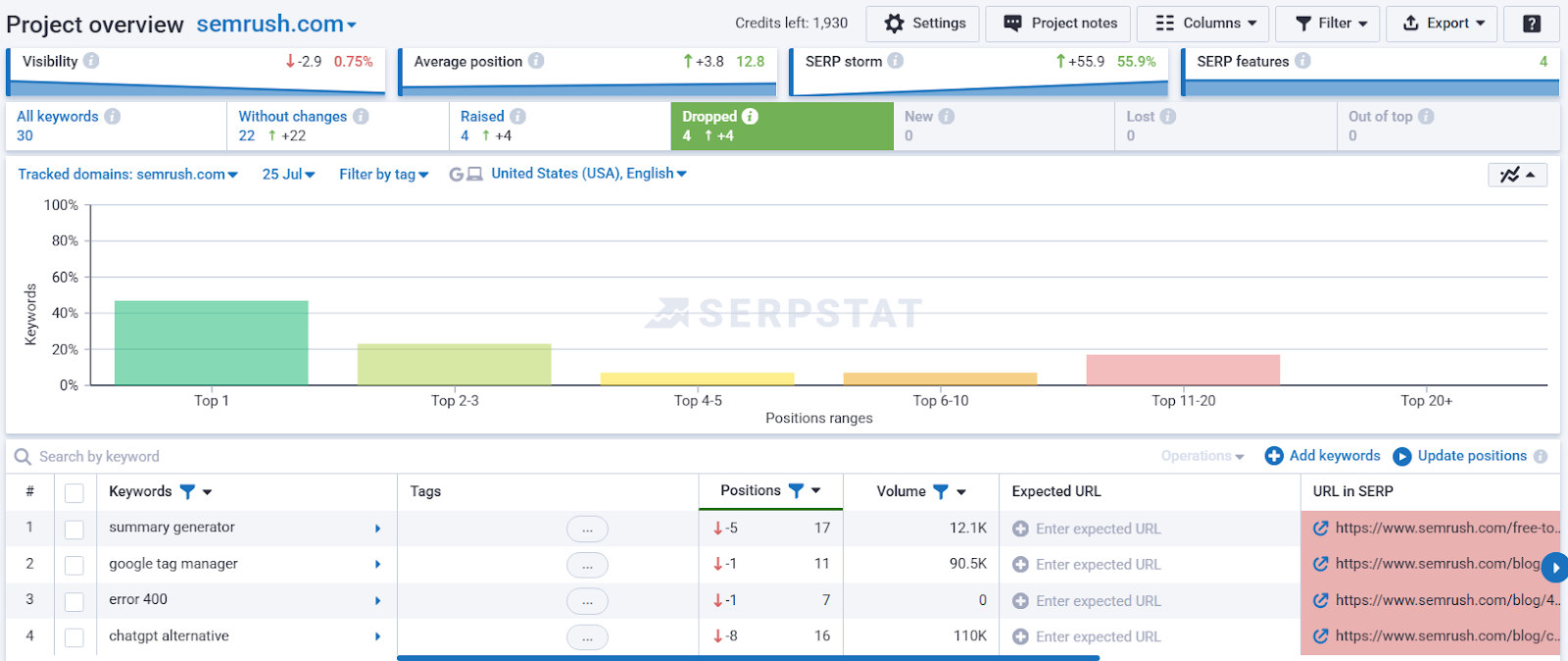
Serpstat also tracks SERP features like AI Overviews. And tells you whether you or another domain holds available SERP features.
You can choose to get keyword updates daily, on certain days of the week, or monthly.
And Serpstat’s “URL in SERP” column lets you manually enter the URL for the page you want to rank for, so you can compare it to which page is actually ranking. To help you identify pages with keyword cannibalization.

What I Like
Serpstat’s storm metric can help you figure out if a fluctuation in your rankings is from an algorithm update or something else.
“Keyword storms” indicate how much the search engine results have changed for a given keyword over time. A higher percentage (greater than 40%) means more rankings have shifted. While a lower percentage means the results have remained relatively stable.
So, say you notice your rankings start fluctuating for an important page. Reviewing the SERP storm metric might give you clues as to why.
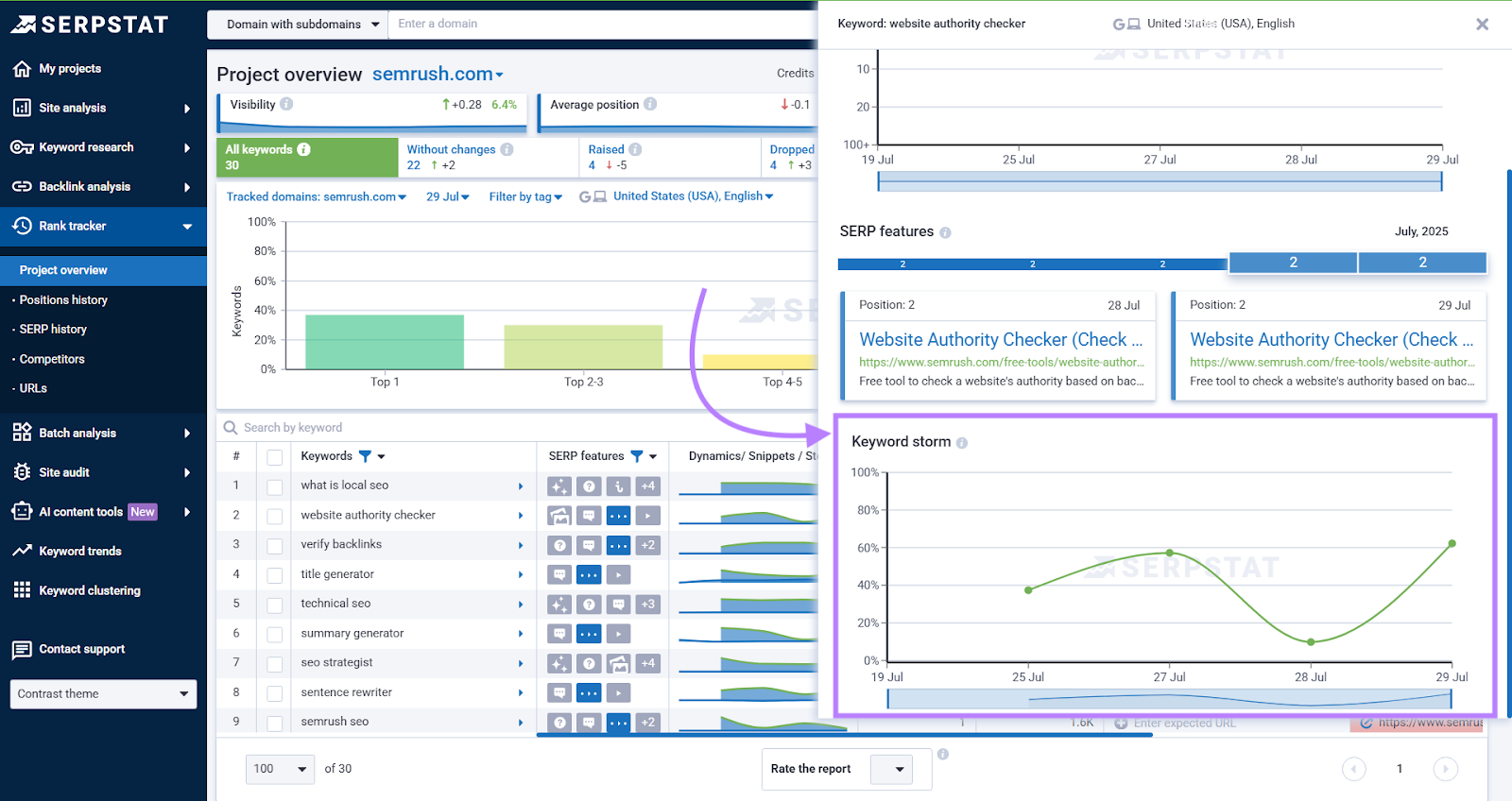
You can also visit Google’s Search Status Dashboard to confirm a suspected update. And sometimes Google will publish what they hope to accomplish with updates on their blog. So you can adjust impacted content.
6. Wincher
- Best for: Lean marketing teams that want easy reporting
- Free basic version available: No
- Pricing: Basic ($49/month), Standard ($89/month), and Professional ($319/month)
- Free trial period: Seven days
Wincher’s rank-tracking tool offers keyword tracking with daily updates for many countries. On-demand updates are also available for Standard and Professional plans.
You’ll get data about a keyword’s triggered SERP features (including AI Overviews), position, search volume, your ranking pages, and more. And you can see all the pages that rank for each keyword to help you spot potential cannibalization issues.
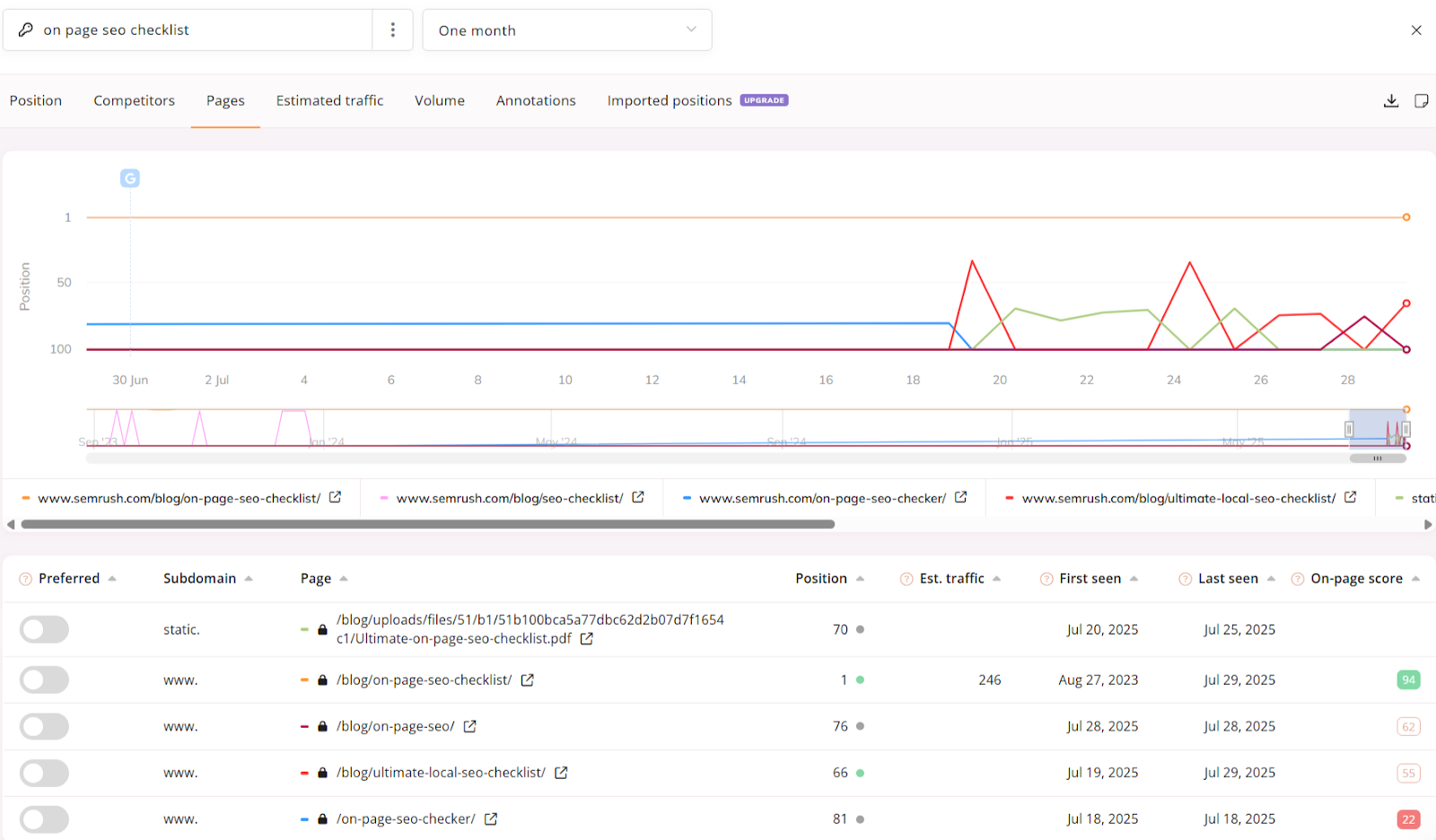
Wincher also lets you track entered competitors to see how rival sites compare to yours.
For example, this bar graph shows an aggregate of your site’s rankings versus competing sites’ rankings.
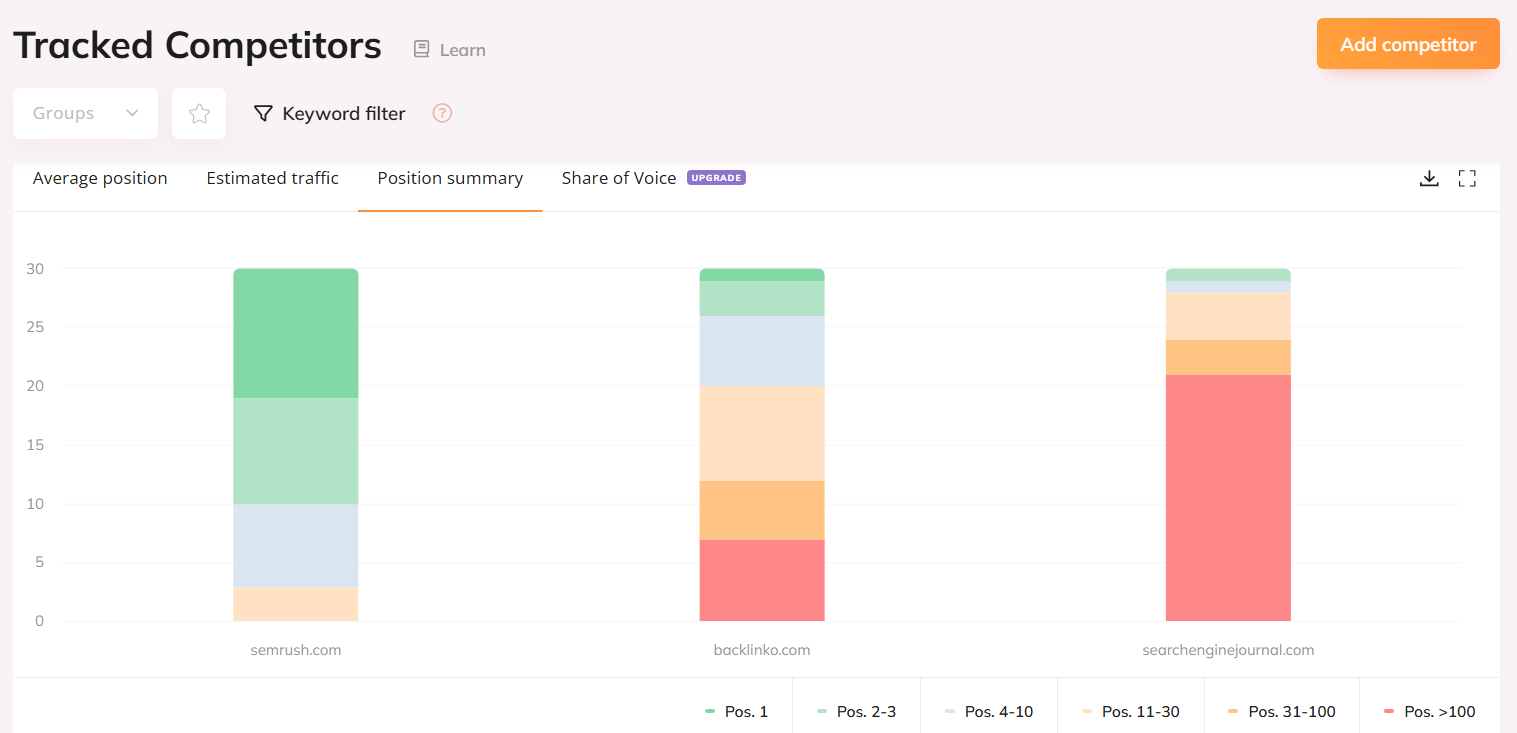
What I Like
Wincher has historical keyword tracking data for up to 24 months that’s available as soon as you create your campaign.
So you can see how your site has performed for your keywords over time—even before you started tracking them. This can make it easier to spot long-term trends. And measure your past SEO efforts.
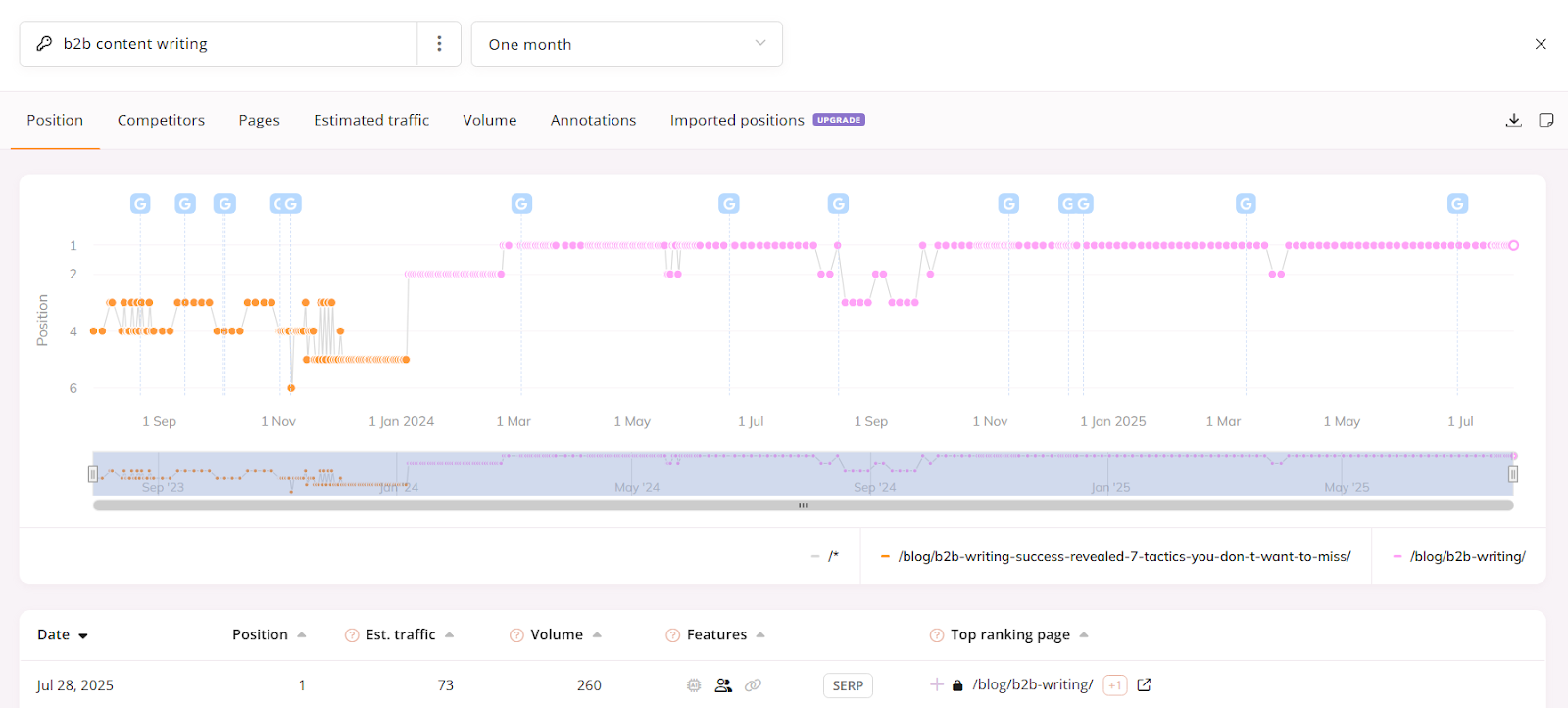
You can apply this historical data to your competitors as well. To see how they’ve performed compared to your site over the last 24 months.
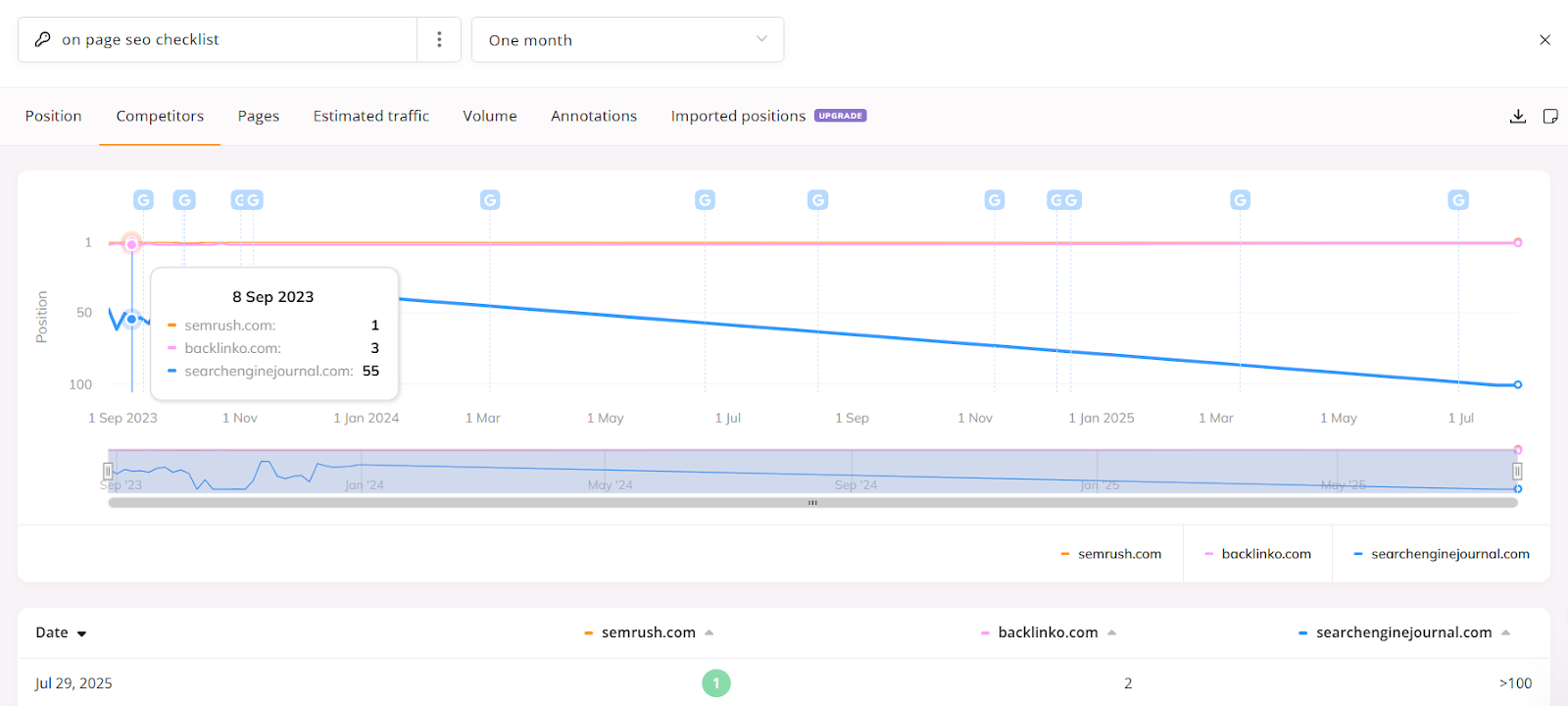
7. Moz Pro
- Best for: Beginners and teams that can stay on track with weekly updates
- Free basic version available: No
- Pricing: Starter ($49/month), Standard ($99/month), Medium ($179/month), and Large ($299/month)
- Free trial period: Seven days
Moz Pro’s keyword tracking tool tracks keyword performance over time for your site and entered competitors. Giving you metrics like your search visibility (an estimated click-through rate—the percentage of users who click a result in the SERPs after seeing it), average ranking, movement, and more.
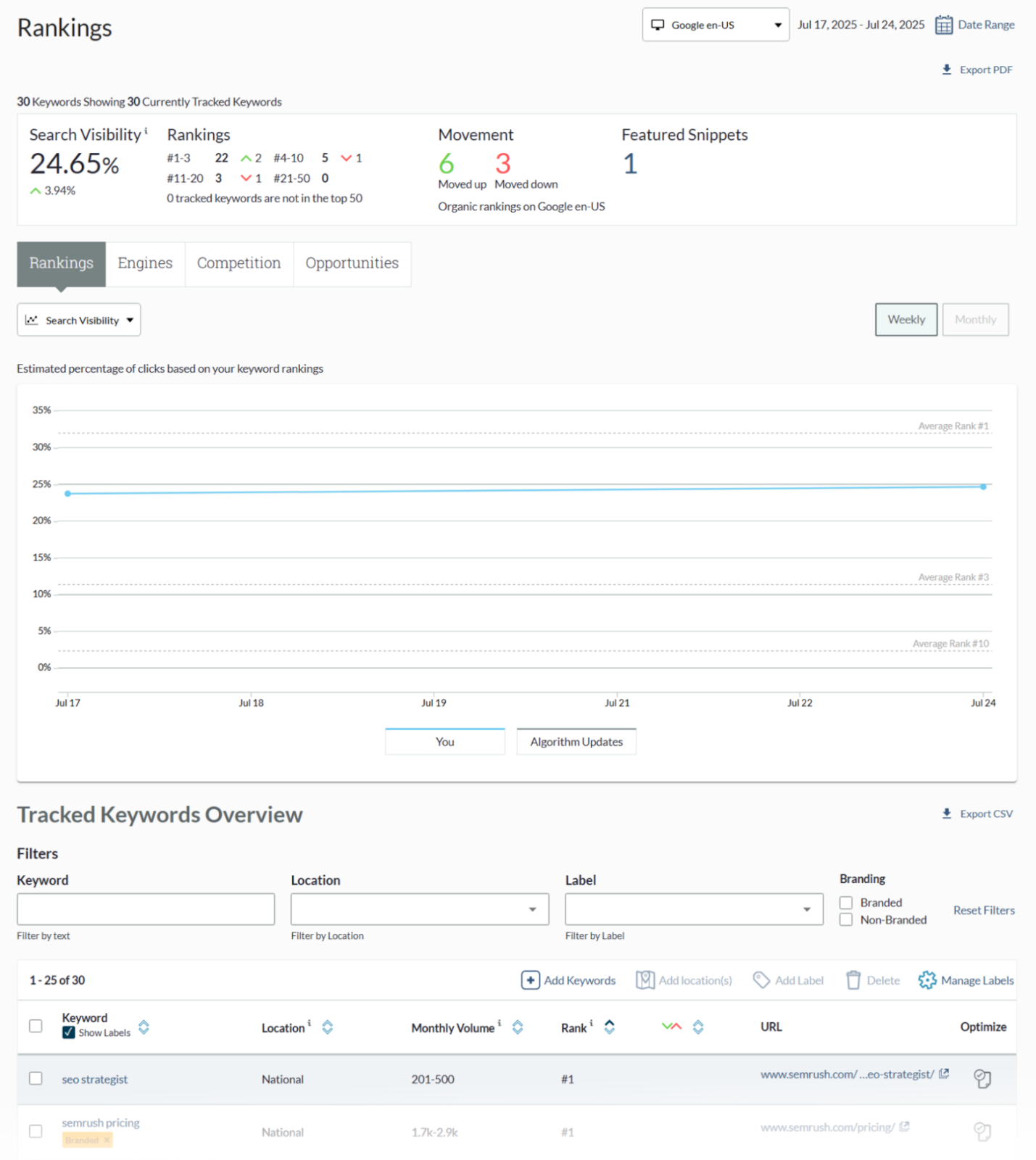
You can track keywords down to the ZIP code level.
And additional reports like “Keywords & Features” show a keyword’s SERP features, along with the ones you rank for and ones your entered competitors rank for.
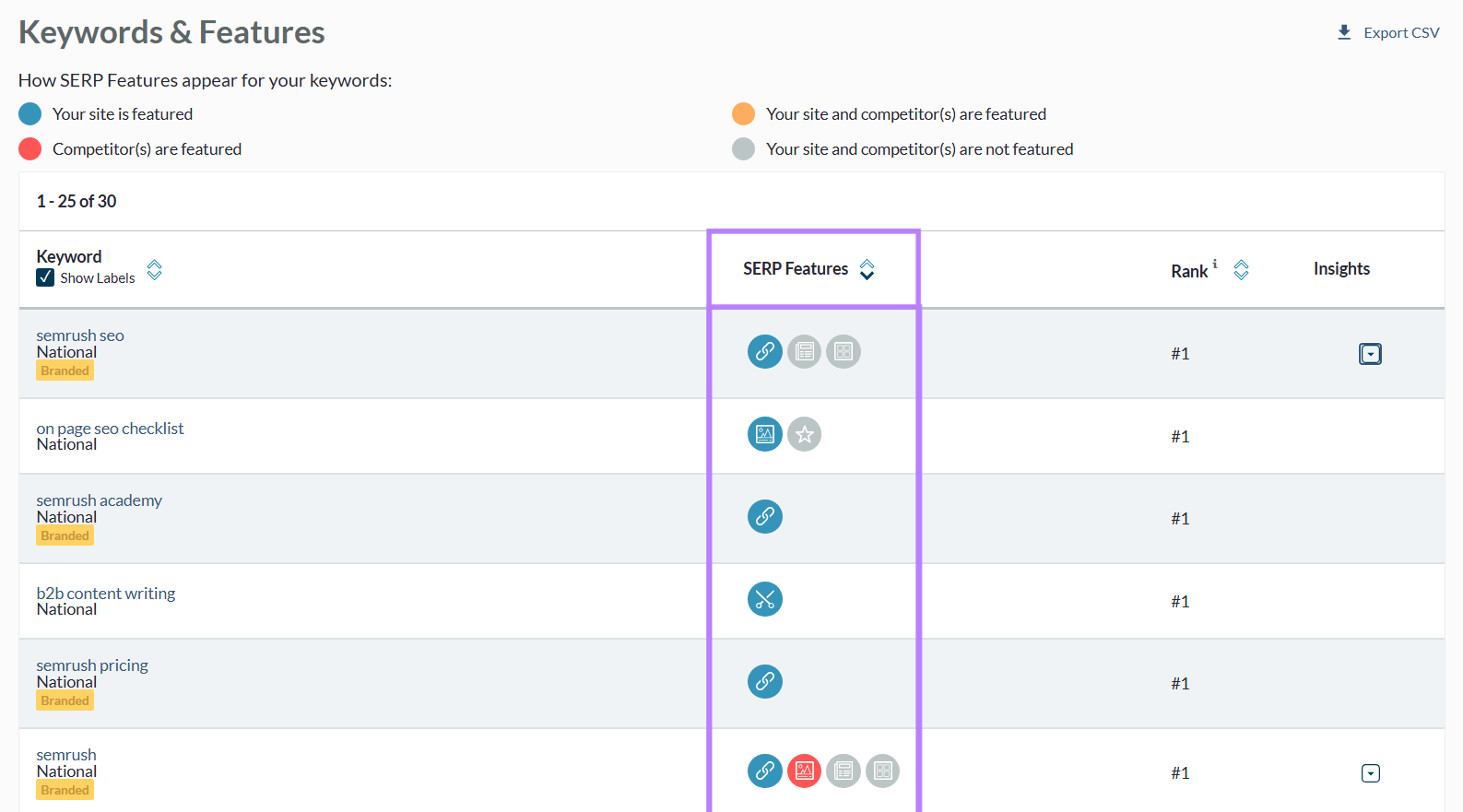
Keyword tracking data is updated weekly in Moz. Which can be suitable for teams that don’t require more frequent reporting.
What I Like
Moz Pro’s “Opportunities” tab shows you keywords that might be sending traffic to your site, but that you aren’t tracking.
These are often quick wins—you could improve your rankings with a little bit of optimization. And adding them to your tracker lets you monitor their performance to make smarter SEO decisions.
You can select the checkbox to add the keyword to your tracker and include it in your campaign.

8. Keyword.com
- Best for: Small agencies and individuals on a tight budget
- Free basic version available: No
- Pricing: $4/month for 50 keywords, $7/month for 100 keywords, etc.
- Free trial period: 14 days
Keyword.com is a rank tracking tool that monitors your keyword positions on Google with updates available daily, weekly, or even bi-hourly.
It supports tracking local keywords down to the ZIP code. And you can also connect your Google Search Console account to uncover keywords you aren’t tracking (that you might want to).
For each tracked keyword, Keyword.com shows data like search intent, rank, SERP features, and more.

And you can see visuals of the SERP history to see where your site has ranked at different times. And which sites might be overtaking you in the SERPs.
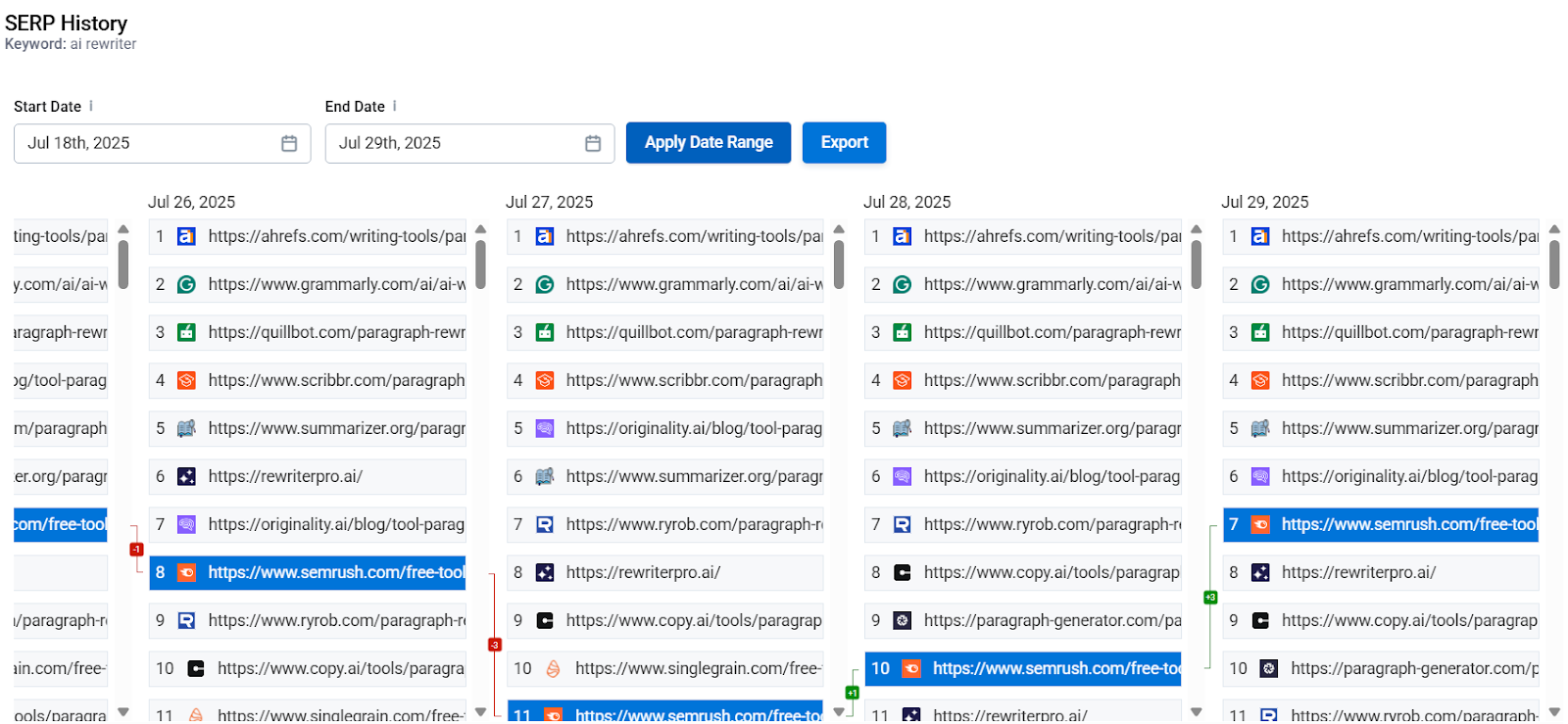
What I Like
Keyword.com has pre-made reports that can help you make sense of your keyword data.
Like this report that shows your SERP feature performance. So you can determine which SERP features you might want to work on capturing.
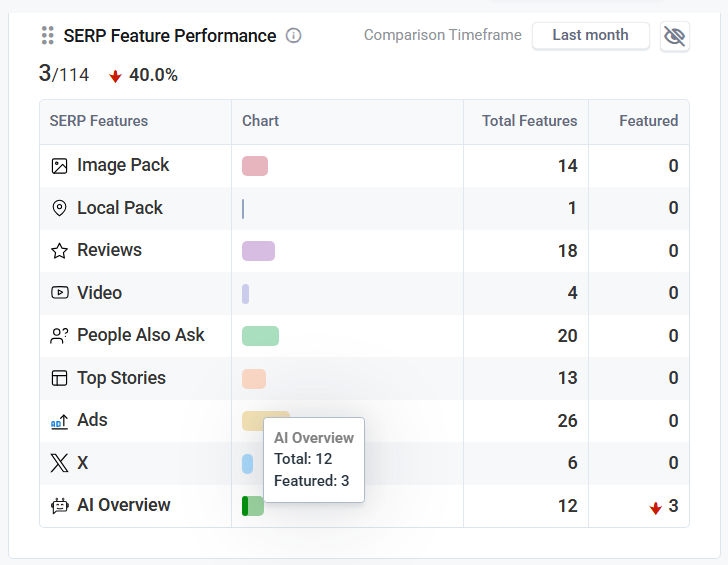
And the “Keywords by Intent” report groups your keywords by search intent (the reason someone searches a query). To help you determine if you need to publish more content with different types of intent.
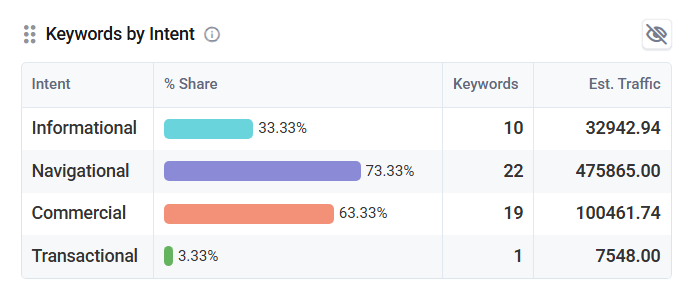
For example, say you run an ecommerce site and see that you don’t rank for many commercial or transactional keywords. You might decide to put time toward trying to rank for keywords that can drive more sales.
9. Mangools
- Best for: Beginners who want actionable, easy-to-understand data
- Free basic version available: Yes
- Pricing: Basic ($49/month), Premium ($69/month), and Agency ($129/month)
- Free trial period: 10 days
Mangools’ SERPWatcher is a keyword tracking tool that provides daily updates and lets you track keywords at the city or designated market area (DMA) level.
You get information for each keyword, including current rank, change in rank from one period to the next, best rank within a selected time frame, search volume, and estimated visits.
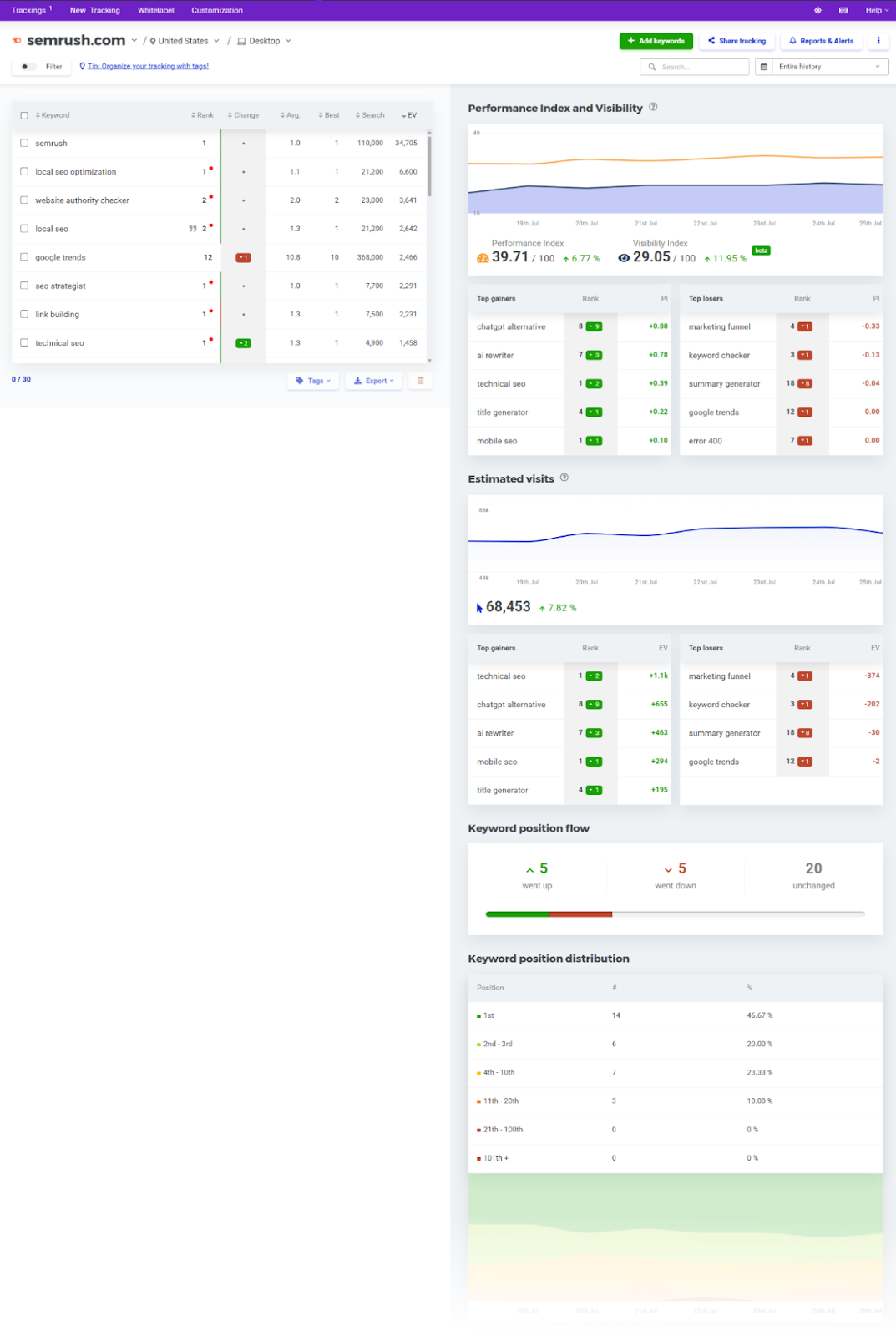
And when you click into a keyword you can get detailed information like how your rankings change over time, ranking URLs, SERP features, and the term’s search volume history.
Additional metrics like “Top” tell you how many pixels from the top of the page a result is.
And “Cov” (coverage) shows how much space your result takes up on the SERP. More coverage (often from elements like sitelinks) usually means higher visibility. Which could lead to better click-through rates.
You can use the coverage metric to spot opportunities to add schema markup (code that helps search engines better understand your site) that makes you eligible for an expanded search listing.
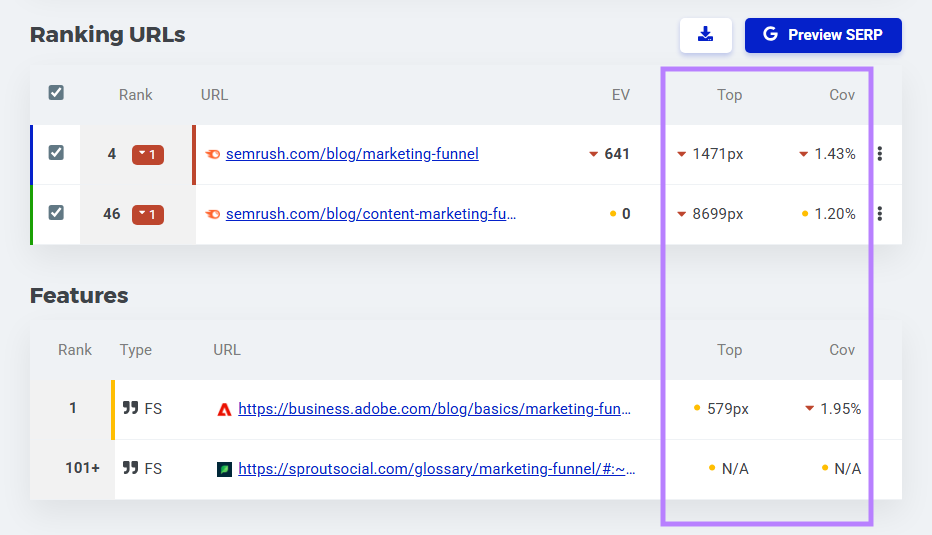
What I Like
I like Mangools’ Performance Index metric—a proprietary score that blends keyword positions and search volumes into a single number to give you a high-level view of your organic performance.
Because the Performance Index is weighted by both ranking position and search volume, it’s not just a simple average. And high-impact keywords (those with higher volume or better rankings) influence the score more.
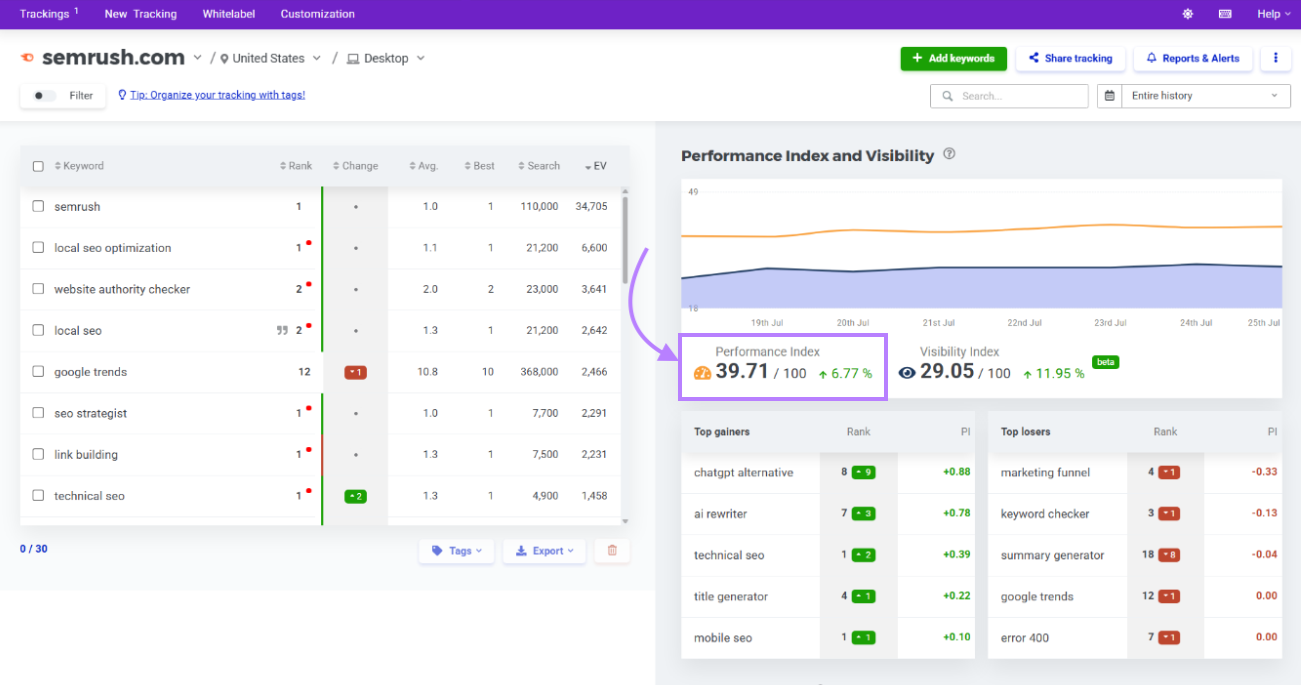
For example, an increasing Performance Index score likely means you're gaining stronger positions for high-volume keywords—the ones most likely to drive meaningful traffic. It can be a quick way to gauge whether your SEO efforts are moving in the right direction.
10. Nozzle
- Best for: Advanced SEO teams that want large amounts of data for their tracked keywords
- Free basic version available: No
- Pricing: SMB ($59/month to $599/month) and Enterprise ($1,199/month to $5,999+/month)
- Free trial period: 14 days
Nozzle is a keyword tracking tool that provides a highly detailed view of your search performance.
It goes beyond position tracking and accounts for your placement in the SERPs by measuring how far your site appears from the top of the page in pixels. Which accounts for elements like ads and carousels.
You’ll also see whether your result appears above the fold (meaning before the user has to scroll), how much of the SERP you occupy, and key performance indicators such as estimated traffic and click-through rate.
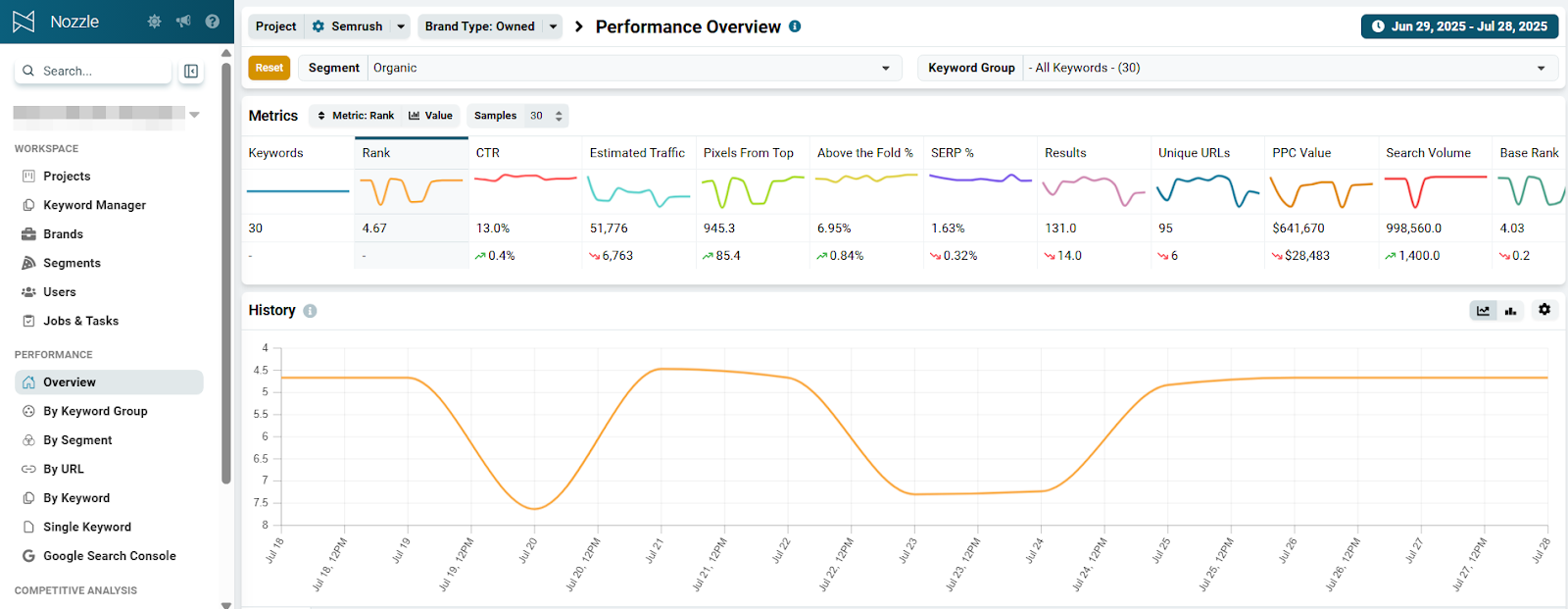
You can track keywords down to specific neighborhoods. And competitor tracking gives teams data they need to understand how visible and competitive their brand is in search results.
Nozzle stores all your data indefinitely. Making it ideal for tracking millions of keywords over time.
What I Like
Nozzle tracks your entire brand (not just your website), so you can get a sense of how much of the first results page you own
For example, Nozzle automatically tracks different branded social profiles—no additional setup required.
Below, we can see what keywords Semrush’s LinkedIn profile ranks for.
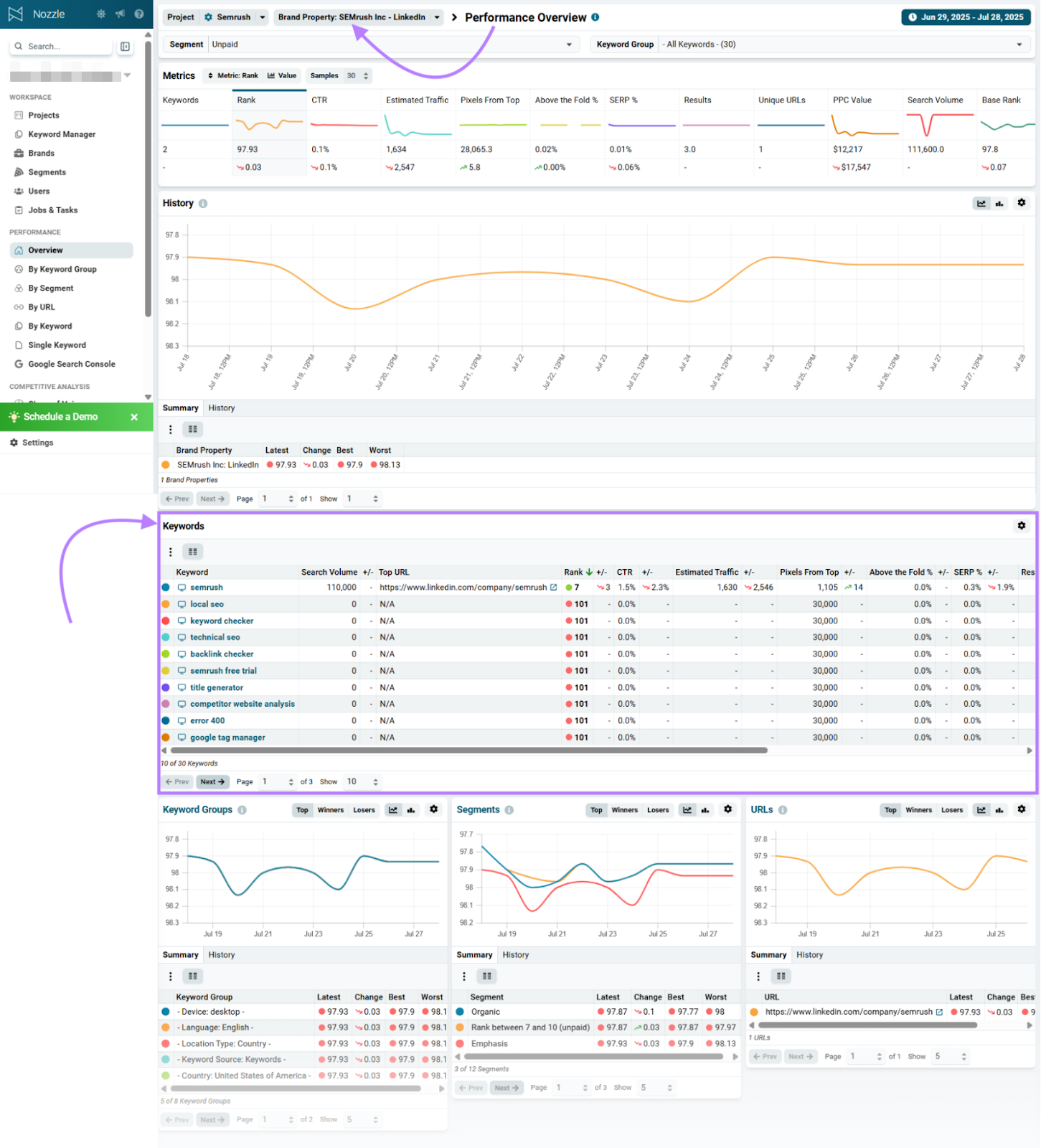
11. Google Search Console
- Best for: Beginners and site owners who want basic performance insights
- Free basic version available: Yes
- Pricing: Free
- Free trial period: Not applicable
Google Search Console (GSC) is a free tool that helps you monitor your site’s presence in search results.
GSC shows keyword data such as:
- Which keywords your site ranks for and your specific ranking positions
- The number of impressions and clicks each keyword receives
- Click-through rate to help you understand how often people click on your listings
- Changes in keyword rankings over time, so you can track SEO progress
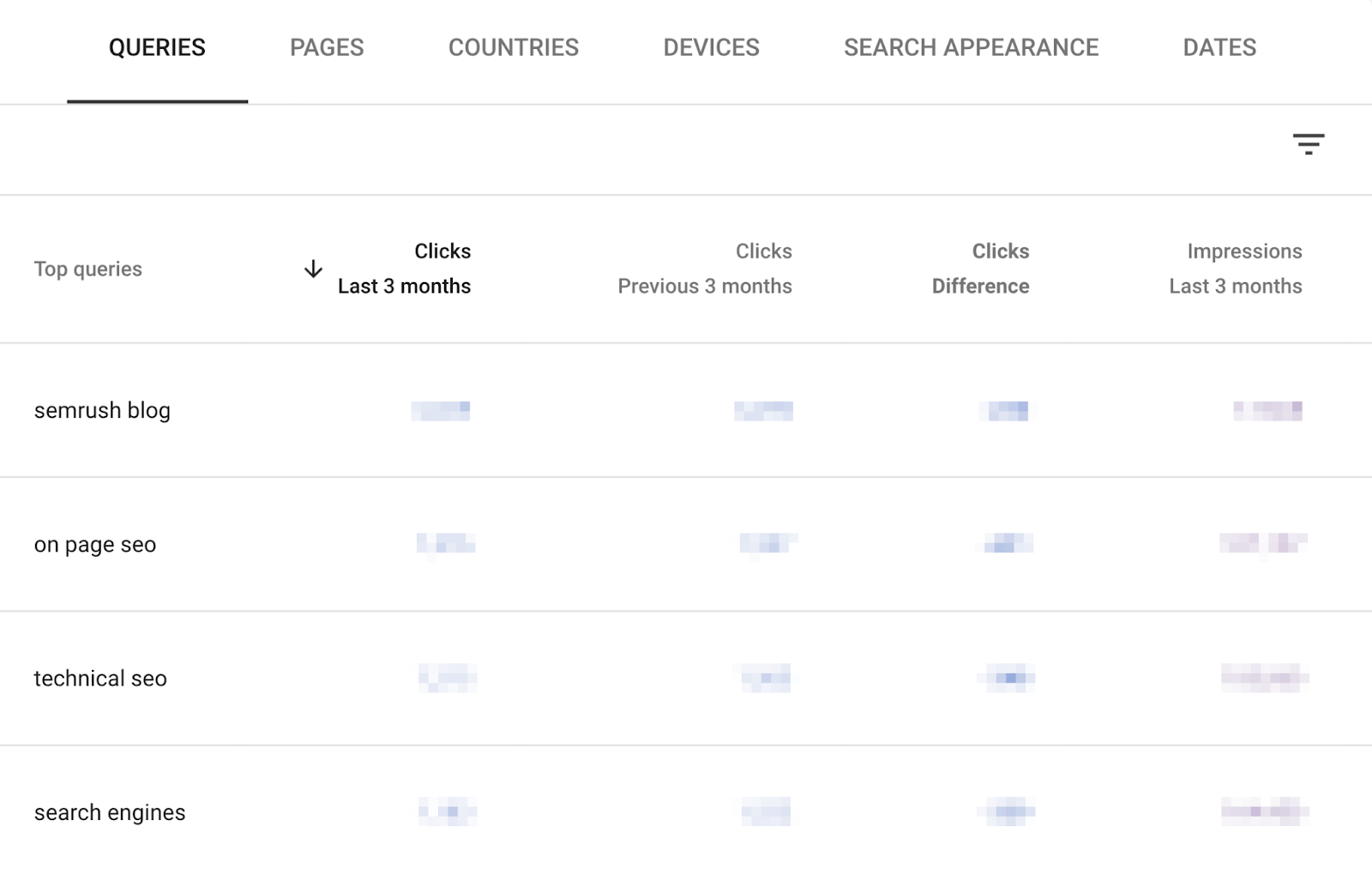
And GSC’s “URL inspection” tool gives you information for an entered URL. Including whether it’s the canonical version (the main version chosen by Google). So you can make sure alternative pages aren’t being prioritized over your preferred page.
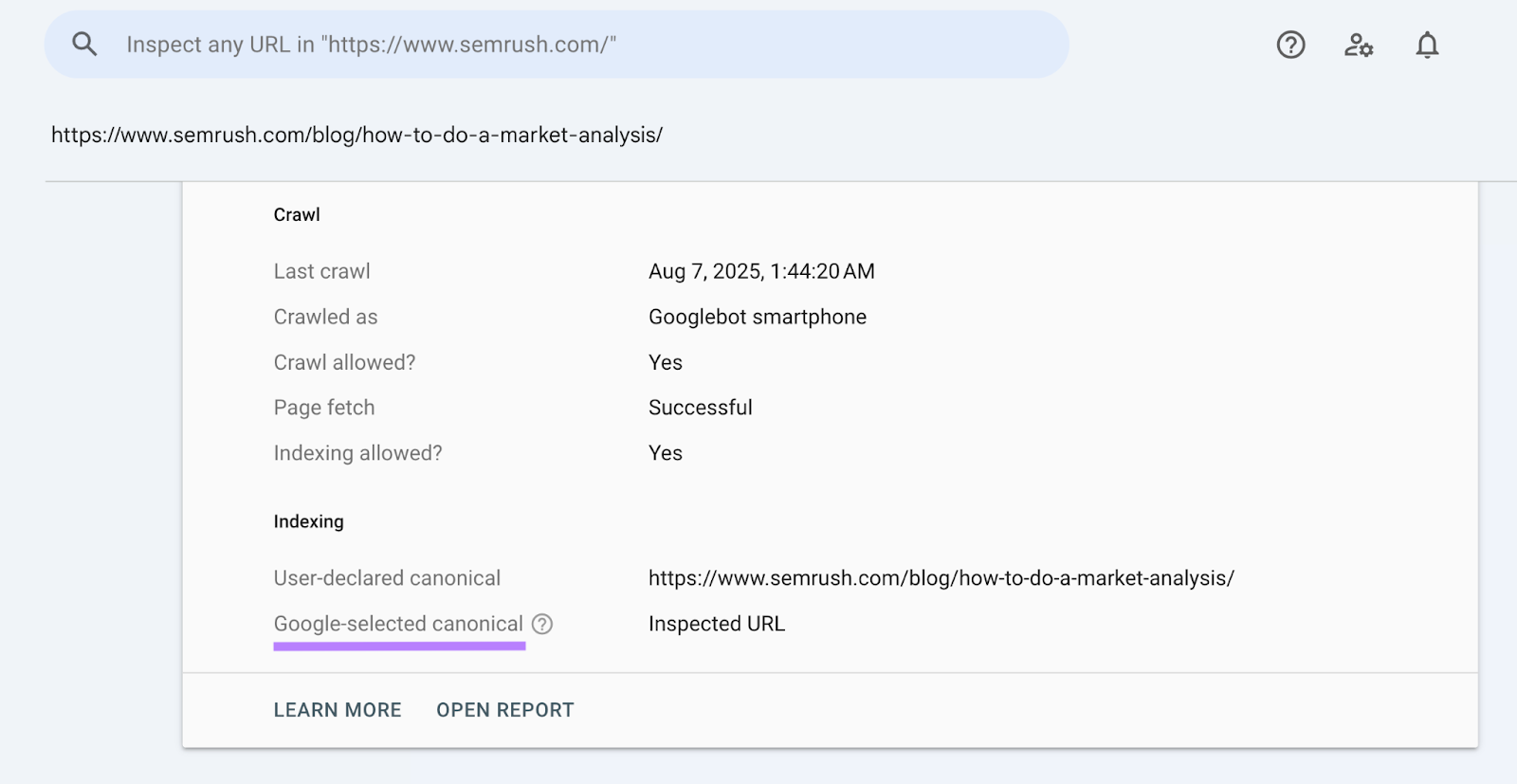
What I Like
GSC’s “Insights” report gives you an overview of how your pages are performing.
Clicking “Trending down” can highlight pages that you might need to optimize. And clicking “Trending up” shows pages that are gaining traction.
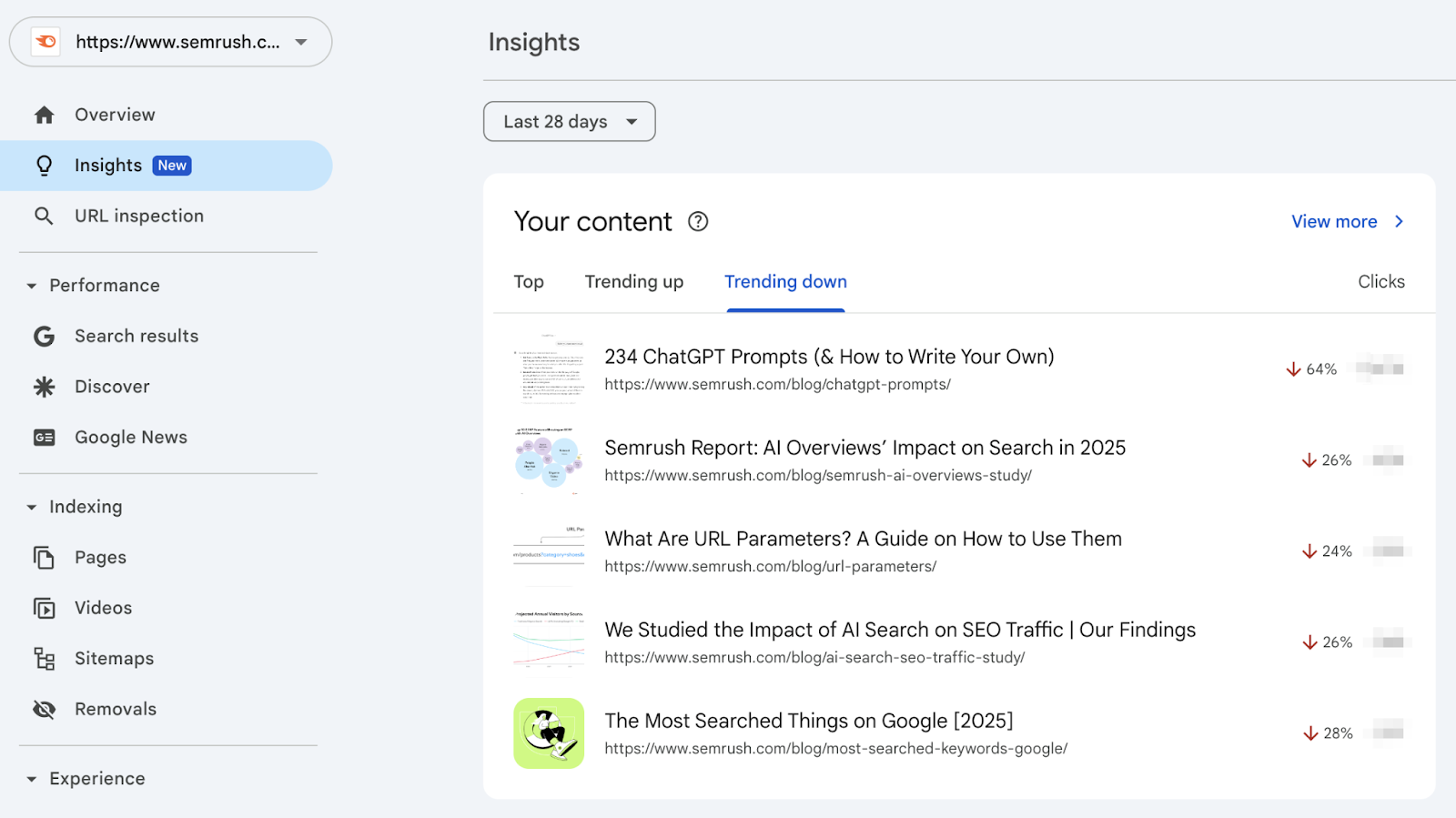
If you click on a result, you’ll see a graph that compares rankings over the past 28 days. Along with a list of the keywords that page ranks for.
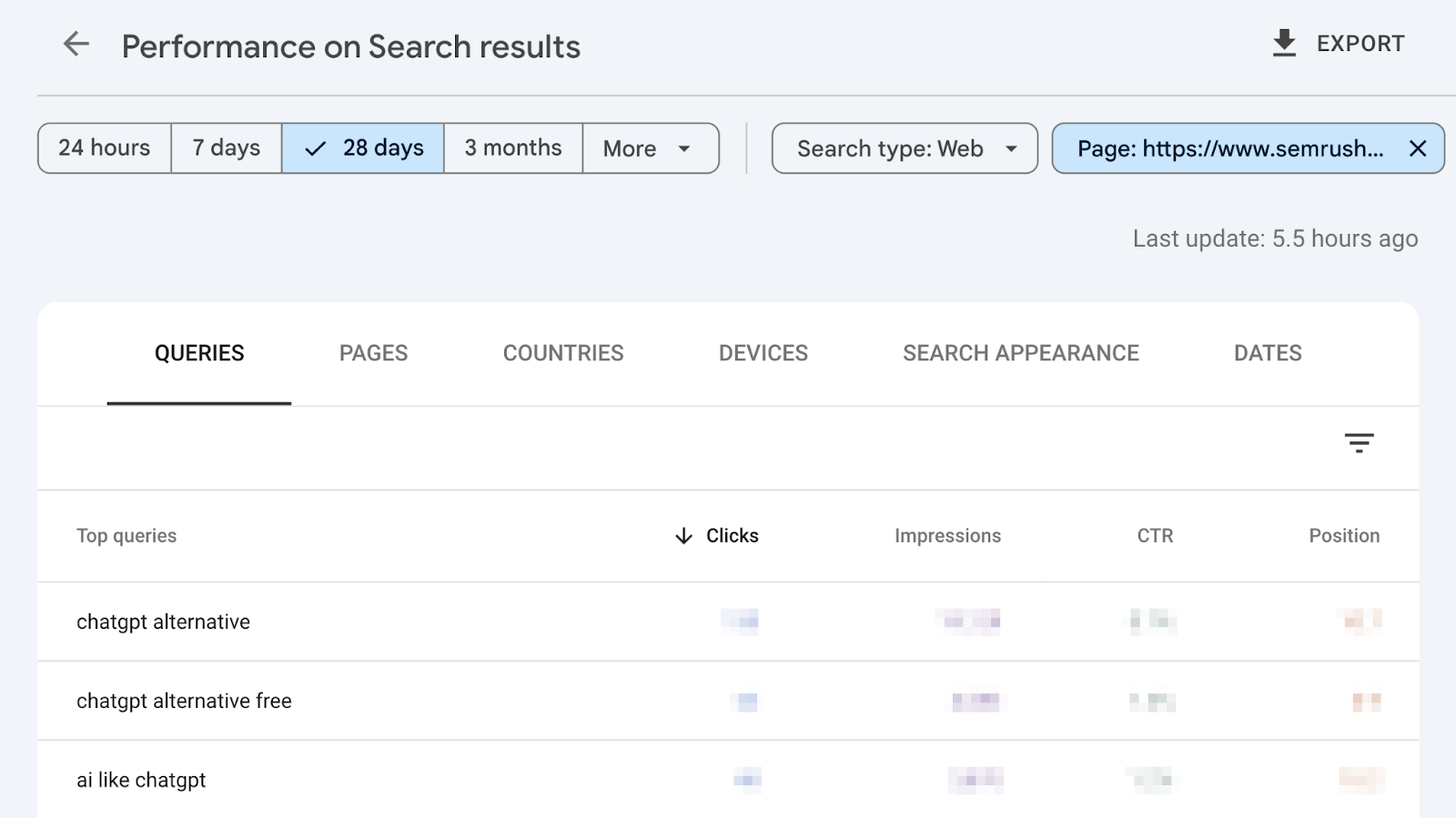
You can see which keywords have changed the most. And use that information to inform your future SEO decisions.
Pick a Tool to Start Keyword Tracking
Choosing a keyword tracking tool depends on your goals, budget, team size, and other specifics.
Here are some tips that can help:
- Clarify your goals. Decide how many terms you need to track, whether you need to monitor specific campaigns, and whether you need to generate reports for clients.
- Define your budget. Factor in the base cost, plus any extras like multiple users, integrations, or advanced reporting features.
- Match the tool to your team. Prioritize simplicity if you’re a beginner. Look for features like API access, unlimited users, and role-based permissions if you work in a larger team.
- Start with a trial. Take advantage of free trials to explore the interface, test reporting speed, and evaluate data quality.
Additionally, look for tools that provide timely updates.
The SERPs can change often, as seen in Semrush Sensor.
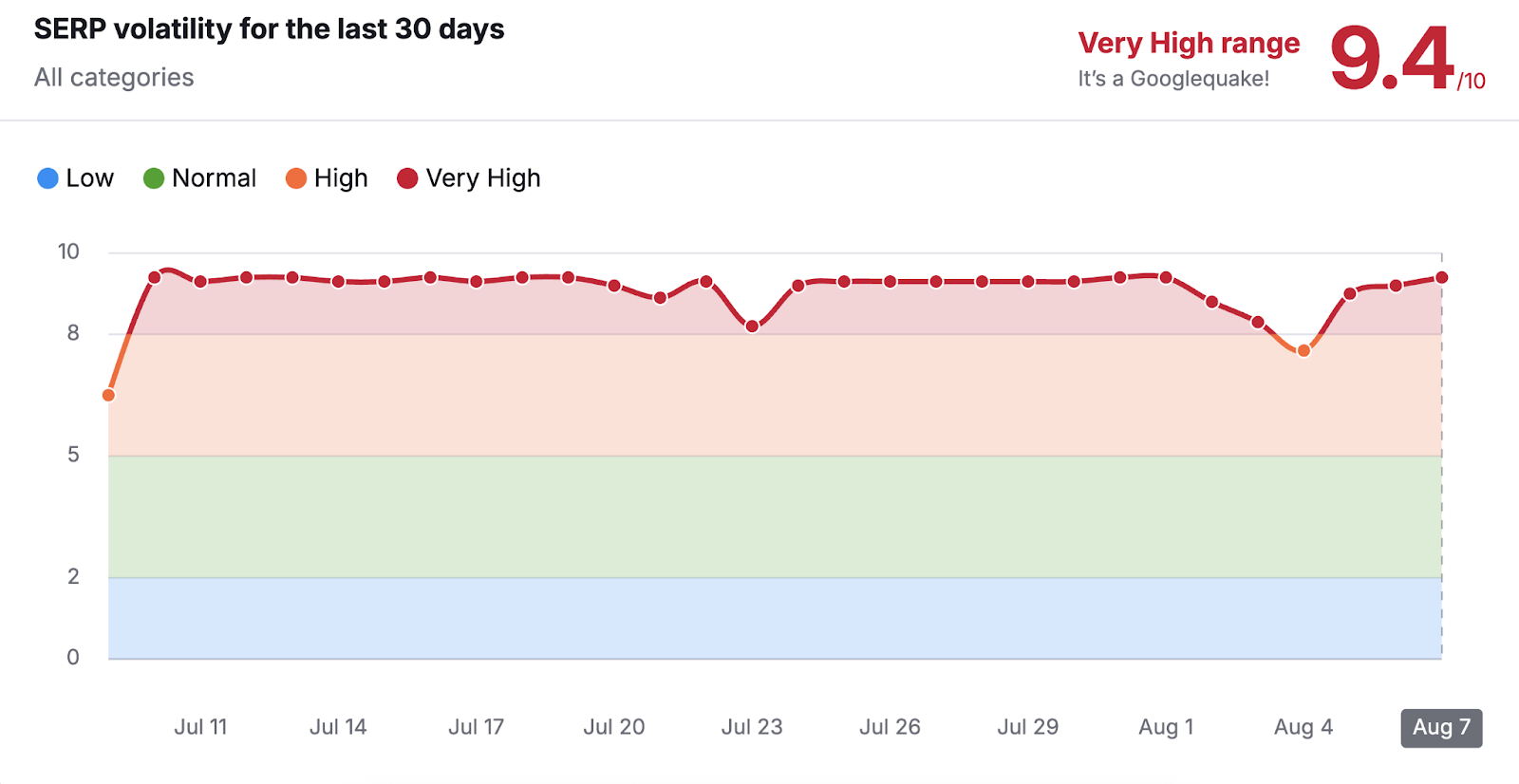
And having a keyword tracking tool like Position Tracking that gives you frequent updates helps you stay ahead of your competitors.
Try it for free.